2016年04月05日
Ogijima-Megijima
The spring session of the Setouchi Triennale 2016 is in full swing. Someone recently asked through this site if it would work to visit Megijima and Ogijima in the same day or better to just do a full day on Ogijima. Here is my answer.
It depends on you. If you are only interested in seeing the art works and are a sturdy walker, then yes, you should have no problem fitting both islands into one day. If you are going to the islands on a weekday, it will not be that crowded either, so you shouldn't need to wait to get in to the art sites. Be sure to check the ferry times carefully before you go though, because if you miss one, you have to wait 2 hours for the next.
For me, personally, it's the islands more than the art that I really want to take time to enjoy, especially if the weather is good. The art sites are really fun and some are quite beautiful, but their purpose is to draw attention to the islands. So I like to stroll around and explore, sit and take in the scenery, talk with strangers, try something to eat at different places, etc. Doing that would take me maybe not a full day on Ogijima, but more than half a day.
I suggest going to Ogijima first and seeing what you think. When you've seen enough, you can hop on the next ferry and go to Megijima.
For those of you with questions, please include your email address so that I can respond to you directly. It may take a few days to get back to you.
It depends on you. If you are only interested in seeing the art works and are a sturdy walker, then yes, you should have no problem fitting both islands into one day. If you are going to the islands on a weekday, it will not be that crowded either, so you shouldn't need to wait to get in to the art sites. Be sure to check the ferry times carefully before you go though, because if you miss one, you have to wait 2 hours for the next.
For me, personally, it's the islands more than the art that I really want to take time to enjoy, especially if the weather is good. The art sites are really fun and some are quite beautiful, but their purpose is to draw attention to the islands. So I like to stroll around and explore, sit and take in the scenery, talk with strangers, try something to eat at different places, etc. Doing that would take me maybe not a full day on Ogijima, but more than half a day.
I suggest going to Ogijima first and seeing what you think. When you've seen enough, you can hop on the next ferry and go to Megijima.
For those of you with questions, please include your email address so that I can respond to you directly. It may take a few days to get back to you.
Posted by cathy at
10:57
│Comments(0)
2015年06月30日
Ritsurin Gourmet Spots
Ritsurin Garden is easily one of Japan’s most beautiful and extensive traditional gardens, as indicated by its 3-star Michelin Guide status. While there are places inside the garden to buy snacks or light meals, it’s also fun to try the restaurants nearby. Here I introduce three that are located near the north gate.
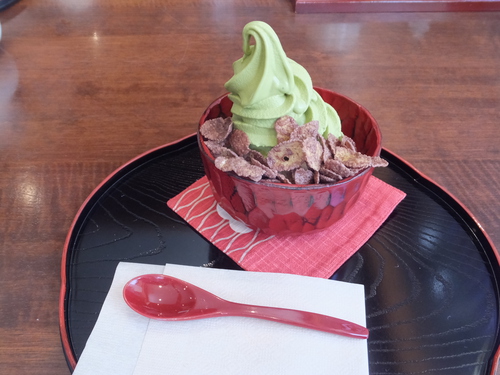
Hotori is literally just outside Ritsurin’s north gate and only 3 minutes from JR Ritsurin Kitaguchi station.

It has a lovely Japanese-style interior complete with a gallery space. It also sells local handicrafts.

One popular item on the menu is an enormously thick slice of sweet potato toast topped with soft ice cream and sweet roasted soy flour. I opted, however, for their regular lunch set. Lunches are JPY950 plus JPY 150 if you order a beverage with it.
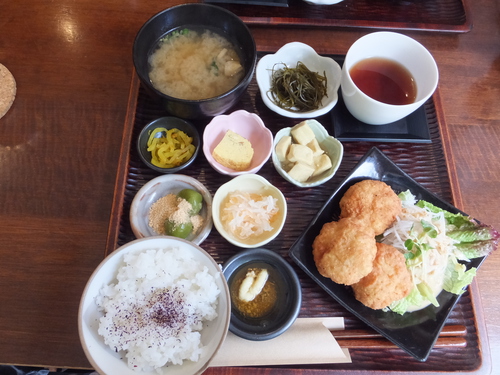
Hotori is open from 9:00 to 18:00 Monday to Saturday, and from 8:00 to 18:00 on Sundays and Holidays, and closed Wednesdays and every 3rd Tuesday.
Address: 32-3 Nakanocho, Takamatsu. No smoking, 10 parking spaces on east side
http://www.ku-zou.com/shop/hotori/
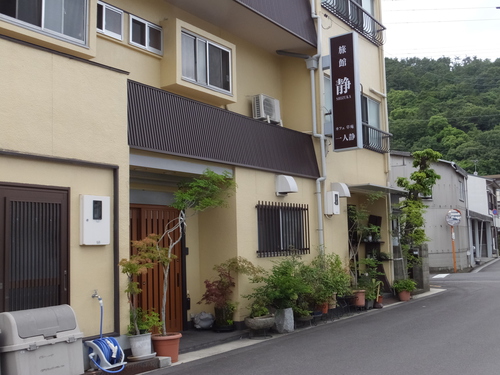
Hitori Shizuka is a café 3-minutes’ walk north of Ritsurin Kitaguchi Station and just 5-minutes from Ritsurin Garden. Run by the owner of the elegant inn next door, it offers a quiet hideaway with a warm and friendly atmosphere, which might be explained by the fact that it’s a real family affair. It’s run by the owner and her daughter-in-law.

The lunch made with locally-produced foods comes with a very generous amount of coffee or tea for only JPY850.
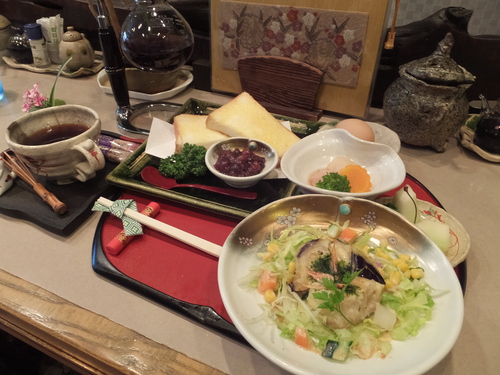
There is also a Japanese breakfast menu, sweets and an assortment of coffees and teas.
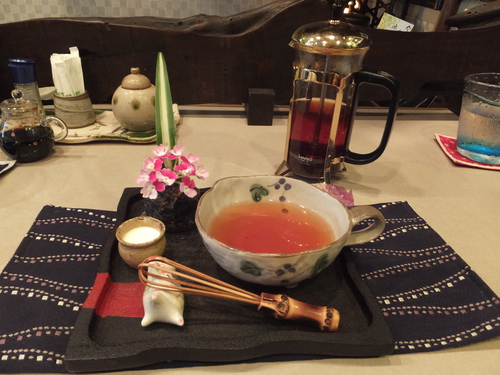
It’s a very popular place so it’s best to make a reservation if you can.
Address: 4-10 Nakano-cho, Takamatsu. 6 parking spots. Hours: 8:00 to 16:00. Closed Sundays, Mondays and national holidays. Map: http://cafe-shizuka.com/map.shtml TEL: 087-861-0530

Finally, a gourmet guide in Takamatsu would not be complete without the local specialty, Sanuki udon noodles. Here let me introduce Matsushita Udon. Established 49 years ago as a noodle factory to supply schools and businesses, it continues the old fashioned-Sanuki custom of serving bowls of noodles on the side to customers who drop in.
The shop owner and master udon maker

Customers heat their own noodles in a vat of hot water and put on their own toppings. Matsushita is a huge favorite with locals and at lunch time you will often see people standing outside and enjoying a bowl of noodles when there’s no room left inside. One bowl costs 200 yen, plus 90 to 100 yen per side dish of tempura, egg, etc.
Heating

Topping
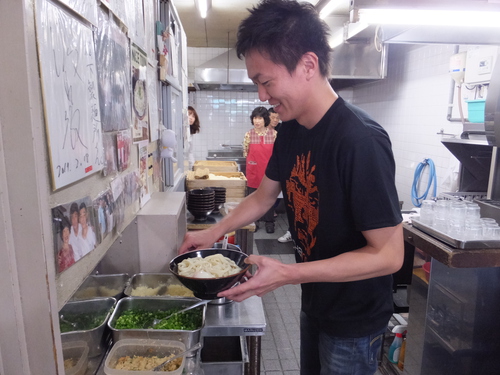
Ready for eating!

Matsushita also makes soba and ramen noodles, which are served with udon soup and, in the case of ramen, pepper. It’s fast, cheap and delicious. It’s open from 7:00 to 17:30 but closes earlier when they run out of noodles. See the URL for a map.
http://www.my-kagawa.jp/udon/detail.php?id=29
For more info on Takamatsu and etc:
http://wikitravel.org/en/Takamatsu
http://www.city.takamatsu.kagawa.jp/english/
http://tia-takamatsu.jp/
http://www.my-kagawa.jp/eg/
http://setouchiexplorer.com/
Hotori is literally just outside Ritsurin’s north gate and only 3 minutes from JR Ritsurin Kitaguchi station.
It has a lovely Japanese-style interior complete with a gallery space. It also sells local handicrafts.
One popular item on the menu is an enormously thick slice of sweet potato toast topped with soft ice cream and sweet roasted soy flour. I opted, however, for their regular lunch set. Lunches are JPY950 plus JPY 150 if you order a beverage with it.
Hotori is open from 9:00 to 18:00 Monday to Saturday, and from 8:00 to 18:00 on Sundays and Holidays, and closed Wednesdays and every 3rd Tuesday.
Address: 32-3 Nakanocho, Takamatsu. No smoking, 10 parking spaces on east side
http://www.ku-zou.com/shop/hotori/
Hitori Shizuka is a café 3-minutes’ walk north of Ritsurin Kitaguchi Station and just 5-minutes from Ritsurin Garden. Run by the owner of the elegant inn next door, it offers a quiet hideaway with a warm and friendly atmosphere, which might be explained by the fact that it’s a real family affair. It’s run by the owner and her daughter-in-law.
The lunch made with locally-produced foods comes with a very generous amount of coffee or tea for only JPY850.
There is also a Japanese breakfast menu, sweets and an assortment of coffees and teas.
It’s a very popular place so it’s best to make a reservation if you can.
Address: 4-10 Nakano-cho, Takamatsu. 6 parking spots. Hours: 8:00 to 16:00. Closed Sundays, Mondays and national holidays. Map: http://cafe-shizuka.com/map.shtml TEL: 087-861-0530
Finally, a gourmet guide in Takamatsu would not be complete without the local specialty, Sanuki udon noodles. Here let me introduce Matsushita Udon. Established 49 years ago as a noodle factory to supply schools and businesses, it continues the old fashioned-Sanuki custom of serving bowls of noodles on the side to customers who drop in.
The shop owner and master udon maker
Customers heat their own noodles in a vat of hot water and put on their own toppings. Matsushita is a huge favorite with locals and at lunch time you will often see people standing outside and enjoying a bowl of noodles when there’s no room left inside. One bowl costs 200 yen, plus 90 to 100 yen per side dish of tempura, egg, etc.
Heating
Topping
Ready for eating!
Matsushita also makes soba and ramen noodles, which are served with udon soup and, in the case of ramen, pepper. It’s fast, cheap and delicious. It’s open from 7:00 to 17:30 but closes earlier when they run out of noodles. See the URL for a map.
http://www.my-kagawa.jp/udon/detail.php?id=29
For more info on Takamatsu and etc:
http://wikitravel.org/en/Takamatsu
http://www.city.takamatsu.kagawa.jp/english/
http://tia-takamatsu.jp/
http://www.my-kagawa.jp/eg/
http://setouchiexplorer.com/
Posted by cathy at
22:05
│Comments(0)
2015年04月30日
Busshozan Revisited
One part of Takamatsu that’s always fun to visit is Busshozan, due south of the city center. This area prospered from the mid-seventeenth century when the ruler established his family temple there. Known as Honenji, that temple alone is well worth a visit (see http://cathy.ashita-sanuki.jp/d2012-11-02.html). In the last decade, new businesses started by the younger generation have sprung up, revitalizing the town. One of these is the Busshozan Hot Spring Bath.

Opened in 2005 by a young entrepreneur and architect when the hot spring waters were first discovered, it’s not only one of the best hot springs on Shikoku, but the building has a lovely design that encourages relaxation.
(see http://www.art-takamatsu.com/blog/2012/03/natural-hot-spring-spa.html).

When I stopped in the other day, I discovered a 50-meter bookstore with used books for 200 yen a piece.

The bathhouse has also become a center for locals to share information and sell their products, and it will be hosting an open air market on May 17 from 12:00-15:00.
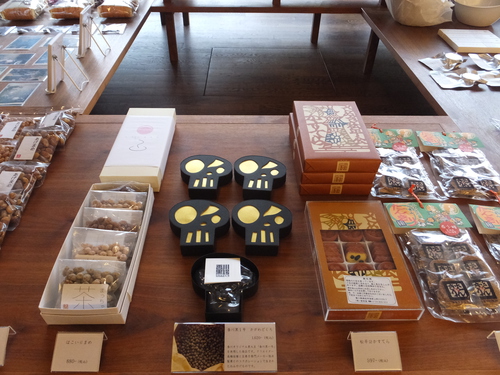
Just down the road from the bath is a brand new addition to Busshozan: ToyToyToy, a shop that opened at the end of March. Run by Yasumasa Konishi, it’s stalked with fun and innovative ‘toys’ and practical items from Japan and abroad. Take this cloth for wiping glasses, for example.

When you bounce it in your hand, as Konishi demonstrates below, it turns into a folded origami crane.
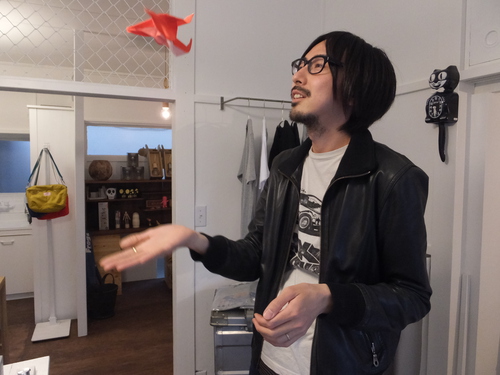

Or how about these wallets made of recycled cardboard? The designs are all one of a kind.


Konishi is not a Busshozan native. While living in northern Kanto, he and his family visited Takamatsu several times and fell in love with this part of it. After the tsunami in 2011, Konishi and his wife were looking for a place to relocate, and were invited by the young entrepreneurs in Busshozan to start up a shop. The vision, he told me, was to create a space that makes people smile. He renovated an old wooden apartment, and his playful spirit is evident in such details as a ceiling covered in tatami floor mats and a lawn and deck outside where kids can play.

He also made a gallery space, which just opened and will be exhibiting works by Gabomi, a local and very talented photographer, from May 2 to May 31 (see www.gabomi.net).
There are lots of exciting developments in Busshozan, but I’ll save them for another time.
TOYTOYTOY
455-2 Busshozan-cho Ko, Takamatsu city, Kagawa, 761-8078, Japan
TEL : (+81)87-814-3959
SHOP HOURS : 12:00~19:00
SHOP HOLIDAYS : MONDAY
Access:
Kotoden train: Take the Kotohira line from Takamatsu Chikko station (near Takamatsu JR station) to Busshozan station (620 yen round-trip, 3 trains/hour; about 18 min. ride). Both TOYTOYTOY and Busshozan Hot Spring are located about 5 to 10 minutes walk east along the road from the station.
For more info on Takamatsu and etc:
http://wikitravel.org/en/Takamatsu
http://www.city.takamatsu.kagawa.jp/english/
http://tia-takamatsu.jp/
http://www.my-kagawa.jp/eg/
http://setouchiexplorer.com/The
Opened in 2005 by a young entrepreneur and architect when the hot spring waters were first discovered, it’s not only one of the best hot springs on Shikoku, but the building has a lovely design that encourages relaxation.
(see http://www.art-takamatsu.com/blog/2012/03/natural-hot-spring-spa.html).
When I stopped in the other day, I discovered a 50-meter bookstore with used books for 200 yen a piece.
The bathhouse has also become a center for locals to share information and sell their products, and it will be hosting an open air market on May 17 from 12:00-15:00.
Just down the road from the bath is a brand new addition to Busshozan: ToyToyToy, a shop that opened at the end of March. Run by Yasumasa Konishi, it’s stalked with fun and innovative ‘toys’ and practical items from Japan and abroad. Take this cloth for wiping glasses, for example.
When you bounce it in your hand, as Konishi demonstrates below, it turns into a folded origami crane.
Or how about these wallets made of recycled cardboard? The designs are all one of a kind.
Konishi is not a Busshozan native. While living in northern Kanto, he and his family visited Takamatsu several times and fell in love with this part of it. After the tsunami in 2011, Konishi and his wife were looking for a place to relocate, and were invited by the young entrepreneurs in Busshozan to start up a shop. The vision, he told me, was to create a space that makes people smile. He renovated an old wooden apartment, and his playful spirit is evident in such details as a ceiling covered in tatami floor mats and a lawn and deck outside where kids can play.
He also made a gallery space, which just opened and will be exhibiting works by Gabomi, a local and very talented photographer, from May 2 to May 31 (see www.gabomi.net).
There are lots of exciting developments in Busshozan, but I’ll save them for another time.
TOYTOYTOY
455-2 Busshozan-cho Ko, Takamatsu city, Kagawa, 761-8078, Japan
TEL : (+81)87-814-3959
SHOP HOURS : 12:00~19:00
SHOP HOLIDAYS : MONDAY
Access:
Kotoden train: Take the Kotohira line from Takamatsu Chikko station (near Takamatsu JR station) to Busshozan station (620 yen round-trip, 3 trains/hour; about 18 min. ride). Both TOYTOYTOY and Busshozan Hot Spring are located about 5 to 10 minutes walk east along the road from the station.
For more info on Takamatsu and etc:
http://wikitravel.org/en/Takamatsu
http://www.city.takamatsu.kagawa.jp/english/
http://tia-takamatsu.jp/
http://www.my-kagawa.jp/eg/
http://setouchiexplorer.com/The
Posted by cathy at
21:39
│Comments(0)
2015年02月28日
New articles
Pat and I have 2 new articles up at http://www.art-takamatsu.com/ Enjoy!
Posted by cathy at
23:16
│Comments(0)
2015年02月01日
more articles up
Dear all,
This is just to let you know that more articles have gone up at http://www.art-takamatsu.com/ . Hope you enjoy them.
Pat and Cathy
This is just to let you know that more articles have gone up at http://www.art-takamatsu.com/ . Hope you enjoy them.
Pat and Cathy
Posted by cathy at
15:59
│Comments(0)
2014年11月28日
New articles up
For those of you who were subscribed to this blog, Pat and I have new articles up again at Art City Takamatsu's new site.
Check here: http://www.art-takamatsu.com/
Or you can click right on the articles here:
http://www.art-takamatsu.com/blog/2014/11/spotlight-on-fall-colors.html
http://www.art-takamatsu.com/blog/2014/11/-wasanbon.html
The technical team is looking into making the new website one you can subscribe to, but until they do that, we'll let you know on this site here each time we put up a new article on the other site.
Thanks for your patience!
Check here: http://www.art-takamatsu.com/
Or you can click right on the articles here:
http://www.art-takamatsu.com/blog/2014/11/spotlight-on-fall-colors.html
http://www.art-takamatsu.com/blog/2014/11/-wasanbon.html
The technical team is looking into making the new website one you can subscribe to, but until they do that, we'll let you know on this site here each time we put up a new article on the other site.
Thanks for your patience!
Posted by cathy at
18:38
│Comments(0)
2014年10月31日
Blog Moved to New Site
Dear Readers,
Thank you for reading this blog and for sending comments and encouragement. The blog has relocated to Art City Takamatsu at the following URL from October 2014. I and Pat Scanlon look forward to updating you on Takamatsu-related information at the new site. See you there. http://www.art-takamatsu.com
Thank you for reading this blog and for sending comments and encouragement. The blog has relocated to Art City Takamatsu at the following URL from October 2014. I and Pat Scanlon look forward to updating you on Takamatsu-related information at the new site. See you there. http://www.art-takamatsu.com
Posted by cathy at
21:12
│Comments(0)
2014年09月21日
International Festival
Takamatsu city puts a lot of effort into making foreign visitors and residents feel welcome. The city’s international association, which is housed in this historic building, provides helpful information in a variety of languages as well as many other services.
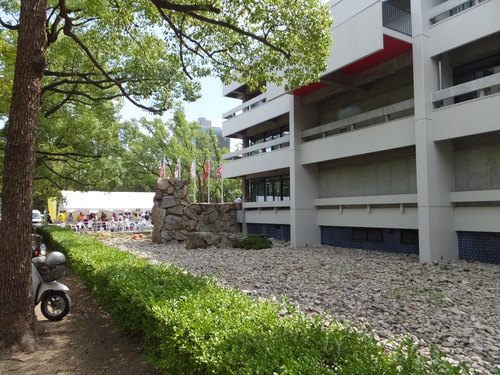
To raise awareness of the need for intercultural understanding and communication and to encourage networking, the city collaborates with the prefecture to host the annual Kagawa International Festival.

This event, which has been held for the last 20 years, brings Japanese and foreign residents together to share and enjoy human diversity. A popular attraction are the many booths serving gourmet food from different countries.
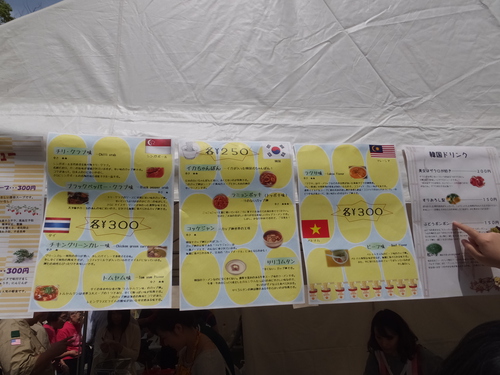
Intercultural menu
In addition to the Japanese festival staple of yakisoba (fried noodles) served by the local Lions’ Club
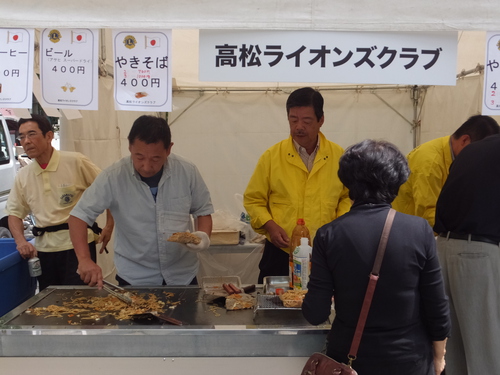
this year’s festival included Korean chijimi
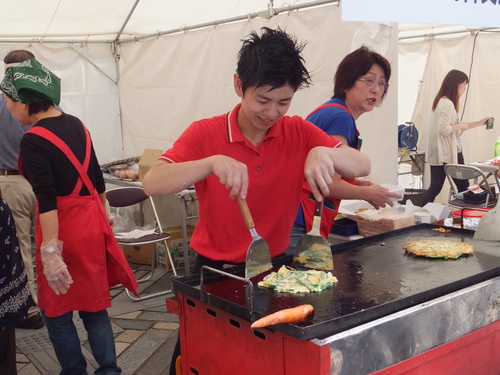
Jamaican brown stew
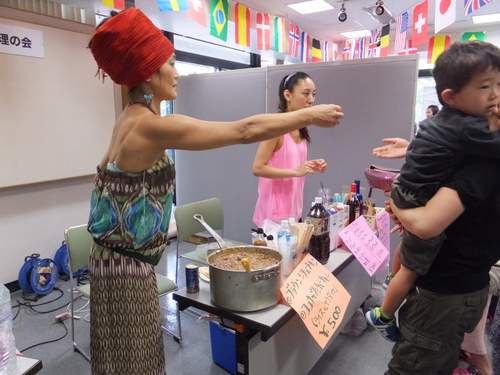
Nepalese curry
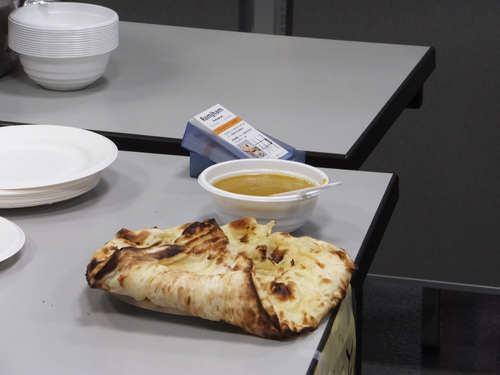
And many other delights. Visitors also get to try wearing the costumes of many different lands, such as these two women here.

The festival is popular with children because there are plenty of games, crafts and workshops to be enjoyed. It also showcases local NGOs and volunteer organizations involved in international assistance and exchange programs. It was great to see groups like the Boy Scouts actively involved, as well as university students who set up booths selling fair trade goods from Cambodia, Laos and other countries,

and promoted awareness of the disparity in wealth through the Table for Two movement.
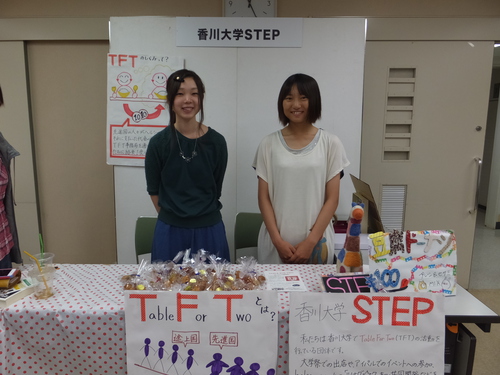
This year’s program featured foreign film screenings, workshops with Kagawan artists and cultural performances, including these lovely Japanese ladies who performed Indonesian dances
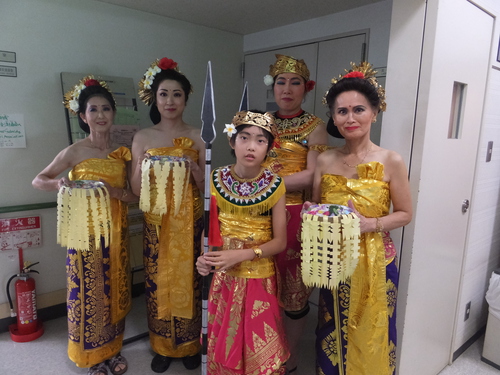
and a troupe of Cambodian children who performed traditional and very dynamic Khmer dances.

These children were invited to Japan by local NGO Second Hand to celebrate its 20th anniversary and raise money for Homeland, a Cambodian orphanage that gives street children and children sold into slavery a haven where they can learn and grow. The troupe performed daily at the JR Takamatsu station as well.

Finally, the festival is just a great place to meet lots of friendly, happy people!
For more info on Takamatsu:
http://wikitravel.org/en/Takamatsu
http://www.city.takamatsu.kagawa.jp/english/
http://tia-takamatsu.jp/
http://www.my-kagawa.jp/eg/
Other Takamatsu bloggers:
http://pat.ashita-sanuki.jp/
http://setouchiexplorer.com/
To raise awareness of the need for intercultural understanding and communication and to encourage networking, the city collaborates with the prefecture to host the annual Kagawa International Festival.
This event, which has been held for the last 20 years, brings Japanese and foreign residents together to share and enjoy human diversity. A popular attraction are the many booths serving gourmet food from different countries.
Intercultural menu
In addition to the Japanese festival staple of yakisoba (fried noodles) served by the local Lions’ Club
this year’s festival included Korean chijimi
Jamaican brown stew
Nepalese curry
And many other delights. Visitors also get to try wearing the costumes of many different lands, such as these two women here.
The festival is popular with children because there are plenty of games, crafts and workshops to be enjoyed. It also showcases local NGOs and volunteer organizations involved in international assistance and exchange programs. It was great to see groups like the Boy Scouts actively involved, as well as university students who set up booths selling fair trade goods from Cambodia, Laos and other countries,
and promoted awareness of the disparity in wealth through the Table for Two movement.
This year’s program featured foreign film screenings, workshops with Kagawan artists and cultural performances, including these lovely Japanese ladies who performed Indonesian dances
and a troupe of Cambodian children who performed traditional and very dynamic Khmer dances.
These children were invited to Japan by local NGO Second Hand to celebrate its 20th anniversary and raise money for Homeland, a Cambodian orphanage that gives street children and children sold into slavery a haven where they can learn and grow. The troupe performed daily at the JR Takamatsu station as well.
Finally, the festival is just a great place to meet lots of friendly, happy people!
For more info on Takamatsu:
http://wikitravel.org/en/Takamatsu
http://www.city.takamatsu.kagawa.jp/english/
http://tia-takamatsu.jp/
http://www.my-kagawa.jp/eg/
Other Takamatsu bloggers:
http://pat.ashita-sanuki.jp/
http://setouchiexplorer.com/
Posted by cathy at
23:07
│Comments(0)
2014年09月20日
The Boat Gym
As I’ve mentioned before, Takamatsu is home to architectural gems designed by some of Japan’s most outstanding architects, including Tadao Ando and Kenzo Tange. One of these is this very distinctive gymnasium by Tange.

Completed in 1964, the same year as the Tokyo Olympics for which Tange created two far more famous arenas, this building has served as a local landmark to several generations.

Model
The rain gutter pictured below spills into a pond that represents Tange’s tribute to the area’s heritage: land reclaimed from the sea to make salt fields.

This history, however, means that the ground is not very stable. The building’s dynamic shape, which earned it the affectionate moniker of “the boat gym”, was a deliberate attempt to compensate for this factor. Rather than resting the structure directly on the ground, which would have required the architect to sink many piles to bear the weight, Tange chose to raise it up and rest it on four massive columns, one at each corner.
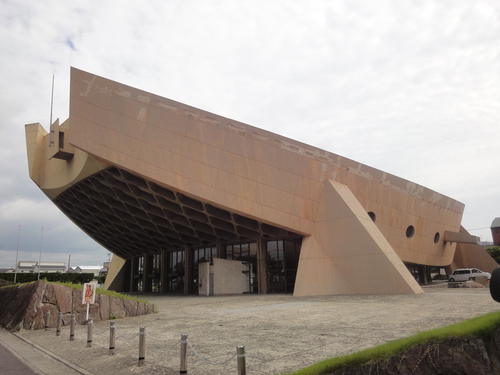
The ends project 20 meters beyond the pillars, and Tange used waffled concrete in place of beams in order to reduce their weight.

Waffle slab
The gym is located on the 3rd floor, and the seating is situated in these two end wings.
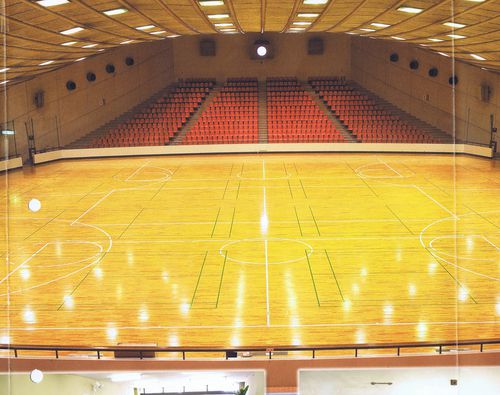
(Photo taken from the gymnasium pamphlet)
The roof, which is suspended on a mesh of wires, looks rather like a canopy or tarpaulin battened onto a boat.

As it turns out, this was the structure’s weak point. Not only is the ceiling height now too low to meet international standards for badminton and rhythmic gymnastics, but the wires used to suspend the roof have corroded. Due to the prohibitive cost of repairs, the building’s future is now uncertain.

The interior features an elegant reception counter designed by Tange himself, as well as chairs designed by the well-known Isamu Kenmochi, reflecting Tange’s custom of collaborating with artists and artisans.


I'll end this little architectural highlight here, but I hope you get the chance to stroll around Takamatsu and find some treasures of your own.
For more info on Takamatsu:
http://wikitravel.org/en/Takamatsu
http://www.city.takamatsu.kagawa.jp/english/
http://tia-takamatsu.jp/
http://www.my-kagawa.jp/eg/
Other Takamatsu bloggers:
http://pat.ashita-sanuki.jp/
http://setouchiexplorer.com/
Completed in 1964, the same year as the Tokyo Olympics for which Tange created two far more famous arenas, this building has served as a local landmark to several generations.
Model
The rain gutter pictured below spills into a pond that represents Tange’s tribute to the area’s heritage: land reclaimed from the sea to make salt fields.
This history, however, means that the ground is not very stable. The building’s dynamic shape, which earned it the affectionate moniker of “the boat gym”, was a deliberate attempt to compensate for this factor. Rather than resting the structure directly on the ground, which would have required the architect to sink many piles to bear the weight, Tange chose to raise it up and rest it on four massive columns, one at each corner.
The ends project 20 meters beyond the pillars, and Tange used waffled concrete in place of beams in order to reduce their weight.
Waffle slab
The gym is located on the 3rd floor, and the seating is situated in these two end wings.

(Photo taken from the gymnasium pamphlet)
The roof, which is suspended on a mesh of wires, looks rather like a canopy or tarpaulin battened onto a boat.
As it turns out, this was the structure’s weak point. Not only is the ceiling height now too low to meet international standards for badminton and rhythmic gymnastics, but the wires used to suspend the roof have corroded. Due to the prohibitive cost of repairs, the building’s future is now uncertain.
The interior features an elegant reception counter designed by Tange himself, as well as chairs designed by the well-known Isamu Kenmochi, reflecting Tange’s custom of collaborating with artists and artisans.
I'll end this little architectural highlight here, but I hope you get the chance to stroll around Takamatsu and find some treasures of your own.
For more info on Takamatsu:
http://wikitravel.org/en/Takamatsu
http://www.city.takamatsu.kagawa.jp/english/
http://tia-takamatsu.jp/
http://www.my-kagawa.jp/eg/
Other Takamatsu bloggers:
http://pat.ashita-sanuki.jp/
http://setouchiexplorer.com/
Posted by cathy at
23:48
│Comments(0)
2014年08月31日
Midsummer’s Night Dream
One of the highlights of summer in Takamatsu this year was the Midsummer’s Night Dream Carnival and Waterfront Festival. Held at Takamatsu Port, it was actually part of three digital media art events held concurrently over a 3-week period. These represented a trial run for an even larger festival to be held next year so if you missed it, you can look forward to more fun in 2015!
Highlights included popular interactive displays at etopia in Sunport

and in the Takamatsu Museum of Art,

The main attraction, however, was a dynamic program of holograms projected onto a giant water screen at Takamatsu Port (unfortunately not very compatible with my camera).

On clear nights, this event attracted huge crowds of up to a thousand people. Thanks to the outdoor venue, however, it never felt overcrowded.
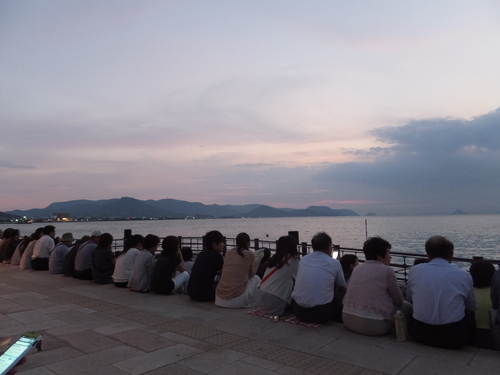
The venue provided the added entertainment of sunset over the Seto Inland Sea.
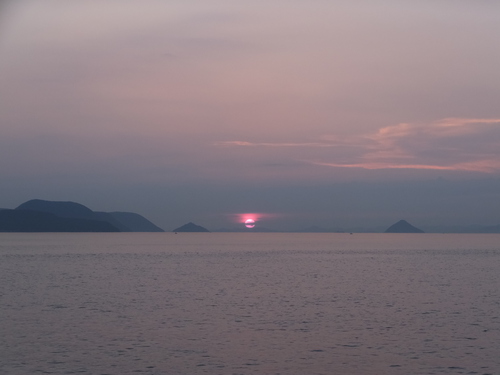
In conjunction with the water screen, which was sponsored by Takamatsu city, the prefecture hosted a portside carnival complete with street performers, dancing, music, and kiosks. I went several times and it was great fun. Different local performers were featured nightly, including a passionate team of flamenco dancers and musicians.

Street buskers included Birdman

and a very entertaining juggler, both from Kanto.

These two transformed into a fire dancing act at night, which was scarily thrilling and quite spectacular in the dark.

They will be back for the Buskers’ Festival in Takamatsu on October 4th, another entertaining annual event with high-caliber free performances. I do recommend having lots of small change on hand, however, as the performers are so good you’ll want to put some money in their hat at the end.
The food provided at the summer event also deserves special mention.
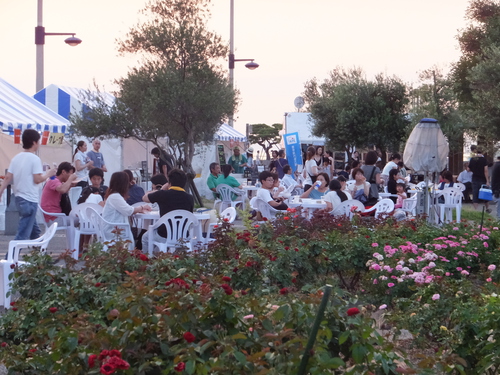
Stalls were run by well-known local entrepreneurs selling delicious fare, including excellent Sanuki noodles, great organic iced coffee made on site, lemon cakes from Teshima island, and specialty beers provided by local Irish pub, The Craic.
I'm looking forward to more next summer!
For more info on Takamatsu:
http://wikitravel.org/en/Takamatsu
http://www.city.takamatsu.kagawa.jp/english/
http://tia-takamatsu.jp/
http://www.my-kagawa.jp/eg/
Other Takamatsu bloggers:
http://pat.ashita-sanuki.jp/
http://setouchiexplorer.com/
Highlights included popular interactive displays at etopia in Sunport
and in the Takamatsu Museum of Art,
The main attraction, however, was a dynamic program of holograms projected onto a giant water screen at Takamatsu Port (unfortunately not very compatible with my camera).
On clear nights, this event attracted huge crowds of up to a thousand people. Thanks to the outdoor venue, however, it never felt overcrowded.
The venue provided the added entertainment of sunset over the Seto Inland Sea.
In conjunction with the water screen, which was sponsored by Takamatsu city, the prefecture hosted a portside carnival complete with street performers, dancing, music, and kiosks. I went several times and it was great fun. Different local performers were featured nightly, including a passionate team of flamenco dancers and musicians.
Street buskers included Birdman
and a very entertaining juggler, both from Kanto.
These two transformed into a fire dancing act at night, which was scarily thrilling and quite spectacular in the dark.
They will be back for the Buskers’ Festival in Takamatsu on October 4th, another entertaining annual event with high-caliber free performances. I do recommend having lots of small change on hand, however, as the performers are so good you’ll want to put some money in their hat at the end.
The food provided at the summer event also deserves special mention.
Stalls were run by well-known local entrepreneurs selling delicious fare, including excellent Sanuki noodles, great organic iced coffee made on site, lemon cakes from Teshima island, and specialty beers provided by local Irish pub, The Craic.
I'm looking forward to more next summer!
For more info on Takamatsu:
http://wikitravel.org/en/Takamatsu
http://www.city.takamatsu.kagawa.jp/english/
http://tia-takamatsu.jp/
http://www.my-kagawa.jp/eg/
Other Takamatsu bloggers:
http://pat.ashita-sanuki.jp/
http://setouchiexplorer.com/
2014年08月24日
A Sea Story
Takamatsu is situated on a sea which until the 19th century had no name. Or rather it had many different names that referred to specific parts of it. It was christened not by the Japanese but by visitors from abroad, who referred to it as the “inland sea” in their travelogues and praised it as one of the most beautiful places on earth. The Japanese adopted the term and it is now the Seto Inland Sea.
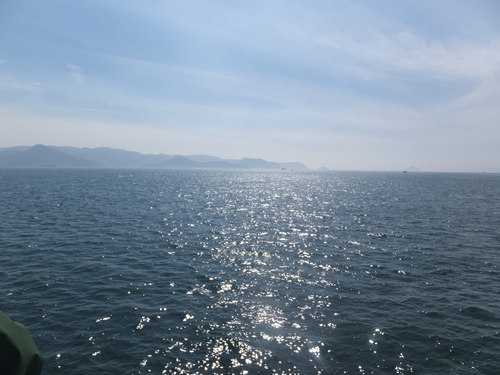
Part of its charm was and still is the distinct culture and character of the people populating its 1,000-plus islands.

Eighty years ago, the Inland Sea was designated as one of Japan’s first national parks. It is also the largest. With the 80th anniversary this year, its national park status is getting some extra attention, which is a very good thing. The Inland Sea is still incredibly beautiful, but we can't afford to take that beauty for granted.
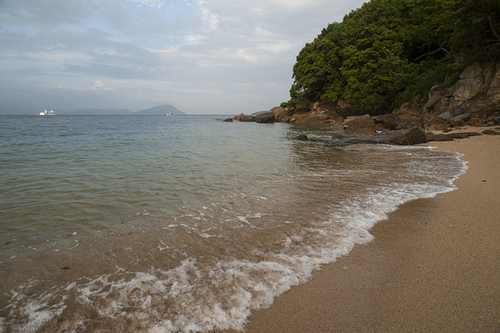
In the mid-20th century, economic and industrial development took precedence over conservation, and some of those scars still remain. Over the last few decades, however, a number of creative efforts have been made to revive both the population and the environment. One such initiative is the Setouchi Trienalle, an international art festival established in 2010 that features art rooted in nature and community life. Such as the paintings on these fishing boats by Team Ogi.


And this installation of bottled memories of island life by Mayumi Kuri.
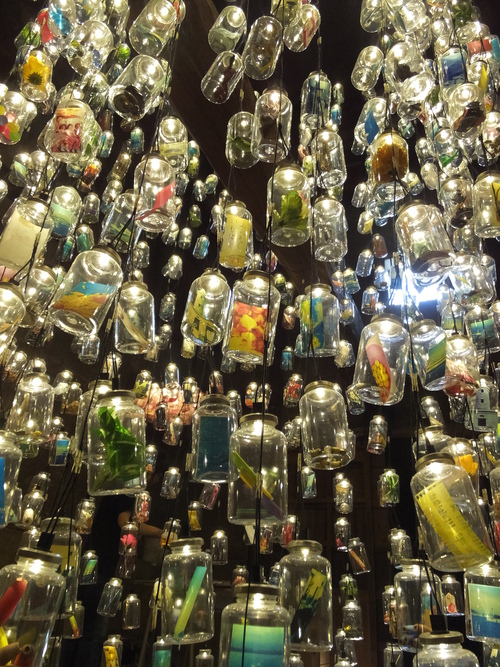
 .
.
The Trienalle appears to be positively impacting the island of Ogijima.

In 2013, a visit during the Trienalle inspired three families to move back to the island, resulting in the reopening of the local school and the construction of a new school building to meet current codes.

Another five people have also relocated to the island, and several new businesses in the form of cafes and rest houses have started up. Early this month, the village held its biannual shrine festival. Despite heavy rain, there was a joyful turnout of elderly islanders with their children and grandchildren who came from various parts of Japan to participate, as well as recent immigrants and Ogijima lovers.

The festival was so packed, it was impossible to get good photos without a ladder so I'll let David tell the story at http://setouchiexplorer.com/ogijima-matsuri-2014/ . On our way out, we got proof that traditional island hospitality is alive and well. This granddad treated us to piping hot snails with soy-vinegar sauce. They were grilled by his grandsons who were visiting for their summer holidays.

For more info on Takamatsu:
http://wikitravel.org/en/Takamatsu
http://www.city.takamatsu.kagawa.jp/english/
http://tia-takamatsu.jp/
http://www.my-kagawa.jp/eg/
Other Takamatsu bloggers:
http://pat.ashita-sanuki.jp/
http://setouchiexplorer.com/
Part of its charm was and still is the distinct culture and character of the people populating its 1,000-plus islands.

Eighty years ago, the Inland Sea was designated as one of Japan’s first national parks. It is also the largest. With the 80th anniversary this year, its national park status is getting some extra attention, which is a very good thing. The Inland Sea is still incredibly beautiful, but we can't afford to take that beauty for granted.

In the mid-20th century, economic and industrial development took precedence over conservation, and some of those scars still remain. Over the last few decades, however, a number of creative efforts have been made to revive both the population and the environment. One such initiative is the Setouchi Trienalle, an international art festival established in 2010 that features art rooted in nature and community life. Such as the paintings on these fishing boats by Team Ogi.
And this installation of bottled memories of island life by Mayumi Kuri.
The Trienalle appears to be positively impacting the island of Ogijima.
In 2013, a visit during the Trienalle inspired three families to move back to the island, resulting in the reopening of the local school and the construction of a new school building to meet current codes.
Another five people have also relocated to the island, and several new businesses in the form of cafes and rest houses have started up. Early this month, the village held its biannual shrine festival. Despite heavy rain, there was a joyful turnout of elderly islanders with their children and grandchildren who came from various parts of Japan to participate, as well as recent immigrants and Ogijima lovers.
The festival was so packed, it was impossible to get good photos without a ladder so I'll let David tell the story at http://setouchiexplorer.com/ogijima-matsuri-2014/ . On our way out, we got proof that traditional island hospitality is alive and well. This granddad treated us to piping hot snails with soy-vinegar sauce. They were grilled by his grandsons who were visiting for their summer holidays.
For more info on Takamatsu:
http://wikitravel.org/en/Takamatsu
http://www.city.takamatsu.kagawa.jp/english/
http://tia-takamatsu.jp/
http://www.my-kagawa.jp/eg/
Other Takamatsu bloggers:
http://pat.ashita-sanuki.jp/
http://setouchiexplorer.com/
Posted by cathy at
21:18
│Comments(0)
2014年07月30日
Staying Cool in Tamamo
Here's a great way to escape the heat on a summer's night in Takamatsu: drop into Tamamo Park, which is just across from the Clement Hotel at Takamatsu Port. Entrance is free from 5PM to 9PM every evening from July 18 to August 31. (Closed on August 13 for the city festival fireworks display.)
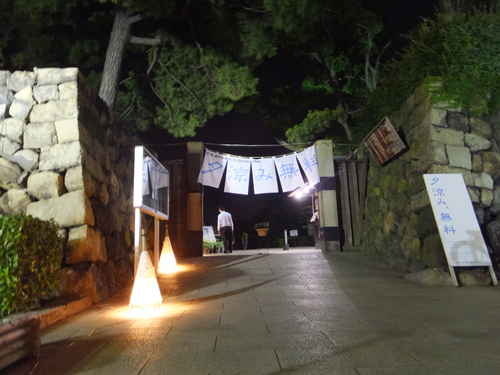
Tamamo Park entrance
The paths are atmospherically lit with lanterns and a cooling mist is piped through the garden.


I happened to go during the Gokan Dining event, which was held from July 19 to 27. This creative initiative by talented local artisans and top-class chefs took place in the stately Hiunkaku, a beautiful 90-year-old wooden manor made by the former lord of the prefecture.

A large hall was transformed into a beautiful dining room decorated with locally produced art and bonsai. Guests were served a fusion of Japanese and Italian cuisine presented on table ware by local potters and lacquerware artists, and were entertained with live music.
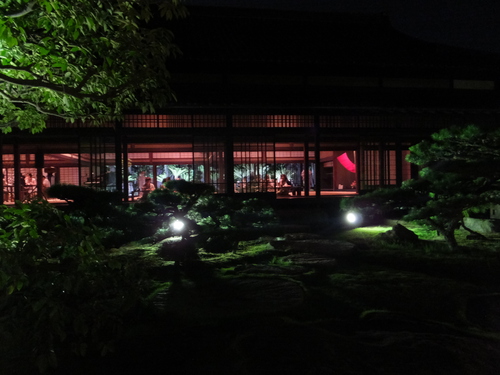
Looking into the dining area

The other rooms served as galleries for the local artisans works and these were open for free to the public. As the dinner was booked solid in advance, I dropped in to enjoy the free art show and was very impressed. Many of the artisans were on hand to explain their work, which made the event both fun and very personal.
There was exquisite lacquer ware by Takako Goto

And some playful metal and plant sculptures by Koichiro Kishi

The artist
They reminded me of Hayao Miyazaki’s Laputa – robots powered by and gradually being consumed by vegetation.

Aji stone workers were on hand as well. They explained that working with artisans in other fields to prepare for this event gives them the chance to learn and experiment with new materials and techniques. In the foreground, you can see an experiment with lacquer on stone.

And then there was the pottery

Including gracefully refined ceramics by Tomomi Hiraoka

And strong, earthy works by Tsuyoshi Ueno.
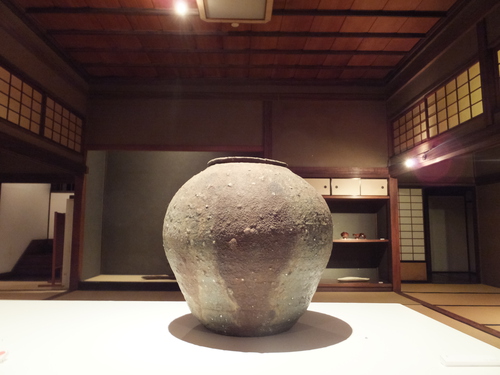
Although the gallery and sensory dining experience are over until next year, the park is still open for free every night until the end of August. So next time you want to escape the heat, visit this Tamamo Park for an evening stroll.
For more info on Takamatsu:
http://wikitravel.org/en/Takamatsu
http://www.city.takamatsu.kagawa.jp/english/
http://tia-takamatsu.jp/
http://www.my-kagawa.jp/eg/
Other Takamatsu bloggers:
http://pat.ashita-sanuki.jp/
http://setouchiexplorer.com/
Tamamo Park entrance
The paths are atmospherically lit with lanterns and a cooling mist is piped through the garden.
I happened to go during the Gokan Dining event, which was held from July 19 to 27. This creative initiative by talented local artisans and top-class chefs took place in the stately Hiunkaku, a beautiful 90-year-old wooden manor made by the former lord of the prefecture.
A large hall was transformed into a beautiful dining room decorated with locally produced art and bonsai. Guests were served a fusion of Japanese and Italian cuisine presented on table ware by local potters and lacquerware artists, and were entertained with live music.
Looking into the dining area
The other rooms served as galleries for the local artisans works and these were open for free to the public. As the dinner was booked solid in advance, I dropped in to enjoy the free art show and was very impressed. Many of the artisans were on hand to explain their work, which made the event both fun and very personal.
There was exquisite lacquer ware by Takako Goto
And some playful metal and plant sculptures by Koichiro Kishi
The artist
They reminded me of Hayao Miyazaki’s Laputa – robots powered by and gradually being consumed by vegetation.
Aji stone workers were on hand as well. They explained that working with artisans in other fields to prepare for this event gives them the chance to learn and experiment with new materials and techniques. In the foreground, you can see an experiment with lacquer on stone.
And then there was the pottery
Including gracefully refined ceramics by Tomomi Hiraoka
And strong, earthy works by Tsuyoshi Ueno.
Although the gallery and sensory dining experience are over until next year, the park is still open for free every night until the end of August. So next time you want to escape the heat, visit this Tamamo Park for an evening stroll.
For more info on Takamatsu:
http://wikitravel.org/en/Takamatsu
http://www.city.takamatsu.kagawa.jp/english/
http://tia-takamatsu.jp/
http://www.my-kagawa.jp/eg/
Other Takamatsu bloggers:
http://pat.ashita-sanuki.jp/
http://setouchiexplorer.com/
タグ :Tamamo Park
Posted by cathy at
00:50
│Comments(0)
2014年07月15日
Waterfront Festival
Looking for a cool way to spend a hot summer evening? Take yourself down to Takamatsu port for the waterfront festival and street carnival from July 19 to August 8.

Just 80 years ago the Seto Inland Sea became Japan’s very FIRST national park. The waterfront event is a creative way to commemorate this historic occasion. Food vendors will line the seafront promenade, and street performers, musicians and dancers will be out to entertain.

But the most intriguing attraction will be an enormous media art show projected onto a 20m x 40m screen of water pumped into the air from the sea. The 15-minute program is divided into 4 parts, some of which appear to be interactive.

DETAILS Waterfront Festival and Carnival:
DATES:July 19th (Sat)〜August 8th (Fri).
TIMES: The street carnival is from 17:00 to 21:00 every night. The giant water screen show, which lasts about 15 minutes, will be staged 3 times per night at the following times (gates open 40 minutes ahead):
1. 19:40〜
2. 20:30〜
3. 21:20〜
*Please note that the show and carnival may be canceled due to bad weather.
PLACE Street Carnival: Sunport Takamatsu, along the waterfront between the Shodoshima ferry terminal and the restaurant Mikayla.
PLACE Giant Water Screen Viewing: On the pier between Mikayla and the red lighthouse. STANDING ROOM ONLY. (There is a special space set aside for people using wheelchairs.)
ADMISSION:FREE *However, please note the following!!!!
Space is limited to only 1,000 so you need to get an advance ticket. The earlier shows on Saturday and Sunday are almost sold out. There are 2 ways to get an advance ticket:
1. Use Ticketpia at any 7/11 convenience store. Input the numbers 627-117, then the date and time of your preferred show and number of tickets you want. You will need to pay 180 yen for the transaction but the tickets are free. (No refund if show is canceled.)
2. Go to the ticket booth near Mikayla any time after 5:00 PM on the day. The organizers said if you plan to line up for a ticket on the day, you are more likely to get one if you go on a weekday, especially for the later shows.
For images and more details in Japanese, check here: http://kagawa.team-lab.net/
There are many related events being held during the same period including an interactive digital art exhibit in e-topia from August 1 to 13, 12:00-20:00 (free), a media art festival pre-event at the Takamatsu Art Gallery from July 23 to August 10 9:30-17:00 (Mondays closed: adults JPY500, students JPY300, under 18 JPY100), and a free performance by the popular Marine Self-Defense Forces Band on July 27 from 5 PM at the large tent-roofed outdoor hall at Sunport. And finally, there's the special dinner event below!
Sensory Dining in Tamamo Park
From July 19-27 (excluding July 23), gourmet cuisine will be served in the stately 90-year old manor located in Tamamo Park. The interior will be artfully decorated with works produced by top Kagawan artists and artisans to create a unique dining experience. Cost: JPY8,500. Dinner from 17:45-19:45 or 20:00-22:00. Call 087-881-2933 for reservations (10:00-17:00 weekdays). http://www.takumikumo.com/
For more info on Takamatsu:
http://wikitravel.org/en/Takamatsu
http://www.city.takamatsu.kagawa.jp/english/
http://tia-takamatsu.jp/
http://www.my-kagawa.jp/eg/
Other Takamatsu bloggers:
http://pat.ashita-sanuki.jp/
http://ogijima.com

Just 80 years ago the Seto Inland Sea became Japan’s very FIRST national park. The waterfront event is a creative way to commemorate this historic occasion. Food vendors will line the seafront promenade, and street performers, musicians and dancers will be out to entertain.

But the most intriguing attraction will be an enormous media art show projected onto a 20m x 40m screen of water pumped into the air from the sea. The 15-minute program is divided into 4 parts, some of which appear to be interactive.

DETAILS Waterfront Festival and Carnival:
DATES:July 19th (Sat)〜August 8th (Fri).
TIMES: The street carnival is from 17:00 to 21:00 every night. The giant water screen show, which lasts about 15 minutes, will be staged 3 times per night at the following times (gates open 40 minutes ahead):
1. 19:40〜
2. 20:30〜
3. 21:20〜
*Please note that the show and carnival may be canceled due to bad weather.
PLACE Street Carnival: Sunport Takamatsu, along the waterfront between the Shodoshima ferry terminal and the restaurant Mikayla.
PLACE Giant Water Screen Viewing: On the pier between Mikayla and the red lighthouse. STANDING ROOM ONLY. (There is a special space set aside for people using wheelchairs.)
ADMISSION:FREE *However, please note the following!!!!
Space is limited to only 1,000 so you need to get an advance ticket. The earlier shows on Saturday and Sunday are almost sold out. There are 2 ways to get an advance ticket:
1. Use Ticketpia at any 7/11 convenience store. Input the numbers 627-117, then the date and time of your preferred show and number of tickets you want. You will need to pay 180 yen for the transaction but the tickets are free. (No refund if show is canceled.)
2. Go to the ticket booth near Mikayla any time after 5:00 PM on the day. The organizers said if you plan to line up for a ticket on the day, you are more likely to get one if you go on a weekday, especially for the later shows.
For images and more details in Japanese, check here: http://kagawa.team-lab.net/
There are many related events being held during the same period including an interactive digital art exhibit in e-topia from August 1 to 13, 12:00-20:00 (free), a media art festival pre-event at the Takamatsu Art Gallery from July 23 to August 10 9:30-17:00 (Mondays closed: adults JPY500, students JPY300, under 18 JPY100), and a free performance by the popular Marine Self-Defense Forces Band on July 27 from 5 PM at the large tent-roofed outdoor hall at Sunport. And finally, there's the special dinner event below!
Sensory Dining in Tamamo Park
From July 19-27 (excluding July 23), gourmet cuisine will be served in the stately 90-year old manor located in Tamamo Park. The interior will be artfully decorated with works produced by top Kagawan artists and artisans to create a unique dining experience. Cost: JPY8,500. Dinner from 17:45-19:45 or 20:00-22:00. Call 087-881-2933 for reservations (10:00-17:00 weekdays). http://www.takumikumo.com/
For more info on Takamatsu:
http://wikitravel.org/en/Takamatsu
http://www.city.takamatsu.kagawa.jp/english/
http://tia-takamatsu.jp/
http://www.my-kagawa.jp/eg/
Other Takamatsu bloggers:
http://pat.ashita-sanuki.jp/
http://ogijima.com
Posted by cathy at
16:41
│Comments(0)
2014年06月30日
Sunset Cruise
This year marks the 80th anniversary of the Seto Inland Sea’s designation as a national park. What better way to celebrate than to enjoy an intimate sunset cruise? That’s exactly what I did this evening, and it was wonderful.
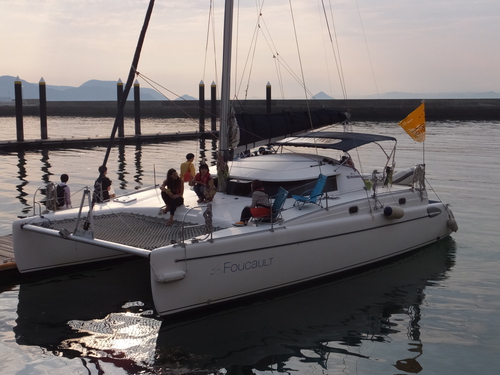
Here’s our beautiful boat – a catamaran.
A team of local Seto Inland Sea lovers have banded together to create their own cruise business called Foucault. They are currently offering 2-hour sunset cruises every Friday through Sunday from about 5:30 to 7:30 PM for up to 17 people.
Some of my fellow shipmates.
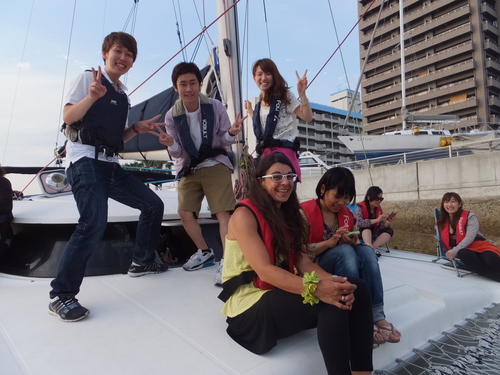

There was a group of university students who belong to the “Kagawaken Lovers” club, a local designer/creator, and a member of the French circus “Cabaret”, as well as a boy and his mother who are originally from Taiwan.
Heading out to sea
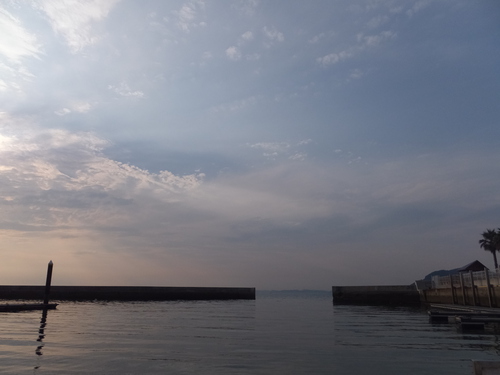
And leaving Takamatsu far behind.
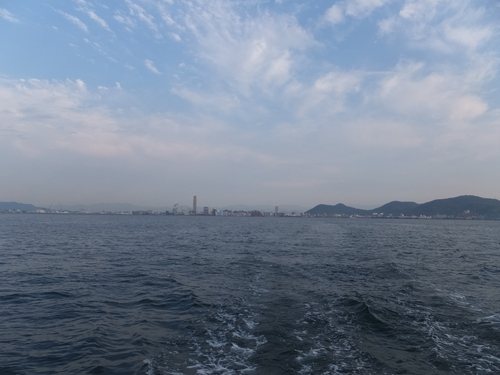
Our guide, Haruyo Horio, took time out from driving occasionally to share his knowledge of the sea and the islands.
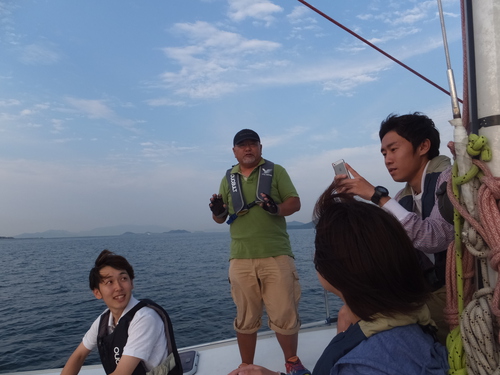
Being very close to the water, the catamaran lets you feel close to the sea, which is both exhilarating and surprisingly relaxing.

Everyone was invited to bring food and drinks so that they could enjoy a picnic on deck

while watching the sun go slowly down. Heaven.



The sunset cruise is just JPY4,000 per person (minimum of 4 people and a maximum of 17). You can also charter a personalized trip to one of over 110 deserted islands where you can stop for a swim and/or a picnic or BBQ. Or you can cruise under the towering Seto Ohashi bridge, one of the longest suspension bridges in the world. If you have a group and an idea, the people at Foucault are willing to consult and come up with a plan. Check out their website for more information (and much nicer photos than mine!). It’s in Japanese only at the moment but they have plans to include English. http://www.foucault.co.jp/
https://www.facebook.com/foucault.setouchi

Coming soon!!
Kagawa Waterfront Festival
July 19-August 8. Will include 15-minute hologram shows on a giant water screen in the sea. Come and enjoy art, dynamic historical storytelling, and entertainment. Shows are at 19:40, 20:30 and 21:20 at Sunport. For more details (in Japanese) see: http://www.pref.kagawa.jp/seto80/event/waterfront.html
Sensory Dining in Tamamo Park
Gourmet cuisine coupled with works produced by top Kagawan artists and artisans makes for a special dining experience. Details are not up yet but last year this special event ran from August 10 through 18. Information will be posted on their website soon: http://www.takumikumo.com/shiro-cafe/
For more info on Takamatsu:
http://wikitravel.org/en/Takamatsu
http://www.city.takamatsu.kagawa.jp/english/
http://tia-takamatsu.jp/
http://www.my-kagawa.jp/eg/
Other Takamatsu bloggers:
http://pat.ashita-sanuki.jp/
http://ogijima.com
Here’s our beautiful boat – a catamaran.
A team of local Seto Inland Sea lovers have banded together to create their own cruise business called Foucault. They are currently offering 2-hour sunset cruises every Friday through Sunday from about 5:30 to 7:30 PM for up to 17 people.
Some of my fellow shipmates.
There was a group of university students who belong to the “Kagawaken Lovers” club, a local designer/creator, and a member of the French circus “Cabaret”, as well as a boy and his mother who are originally from Taiwan.
Heading out to sea
And leaving Takamatsu far behind.
Our guide, Haruyo Horio, took time out from driving occasionally to share his knowledge of the sea and the islands.
Being very close to the water, the catamaran lets you feel close to the sea, which is both exhilarating and surprisingly relaxing.
Everyone was invited to bring food and drinks so that they could enjoy a picnic on deck
while watching the sun go slowly down. Heaven.
The sunset cruise is just JPY4,000 per person (minimum of 4 people and a maximum of 17). You can also charter a personalized trip to one of over 110 deserted islands where you can stop for a swim and/or a picnic or BBQ. Or you can cruise under the towering Seto Ohashi bridge, one of the longest suspension bridges in the world. If you have a group and an idea, the people at Foucault are willing to consult and come up with a plan. Check out their website for more information (and much nicer photos than mine!). It’s in Japanese only at the moment but they have plans to include English. http://www.foucault.co.jp/
https://www.facebook.com/foucault.setouchi
Coming soon!!
Kagawa Waterfront Festival
July 19-August 8. Will include 15-minute hologram shows on a giant water screen in the sea. Come and enjoy art, dynamic historical storytelling, and entertainment. Shows are at 19:40, 20:30 and 21:20 at Sunport. For more details (in Japanese) see: http://www.pref.kagawa.jp/seto80/event/waterfront.html
Sensory Dining in Tamamo Park
Gourmet cuisine coupled with works produced by top Kagawan artists and artisans makes for a special dining experience. Details are not up yet but last year this special event ran from August 10 through 18. Information will be posted on their website soon: http://www.takumikumo.com/shiro-cafe/
For more info on Takamatsu:
http://wikitravel.org/en/Takamatsu
http://www.city.takamatsu.kagawa.jp/english/
http://tia-takamatsu.jp/
http://www.my-kagawa.jp/eg/
Other Takamatsu bloggers:
http://pat.ashita-sanuki.jp/
http://ogijima.com
Posted by cathy at
10:18
│Comments(0)
2014年06月27日
For the Love of Noodles
My cousin recently visited Takamatsu to do an article for an inflight magazine on Sanuki udon, the delicious wheat noodles that have made this area famous throughout Japan. When procured locally, they are not only delicious but incredibly cheap. As we talked udon and ate udon, I wondered what is it that makes these noodles so special?

Piping hot noodles with butter, fresh-ground pepper and egg at Bakaichidai, Takamatsu
Sanuki udon is both the fast food and the comfort food of Kagawa. As this is the driest region of Japan, people traditionally grew wheat, which requires much less water, to supplement the rice crop, and wheat noodles remain a local staple.
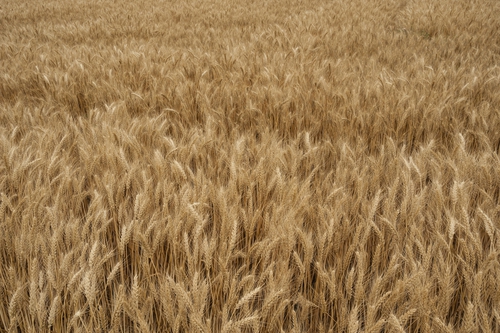
Wheat growing near my house in Takamatsu
Thanks to modern machinery, udon equivalent in texture and taste can now be had not only all over Japan but in other countries as well. While the noodles are good, however, I can testify that something vital is missing.

Udon-making machine in a Sanuki udon shop in Tokyo
Take pride and passion, for instance. Until recently, many Kagawans made udon at home. Traditionally, the firm, silky texture was produced by kneading with the feet.
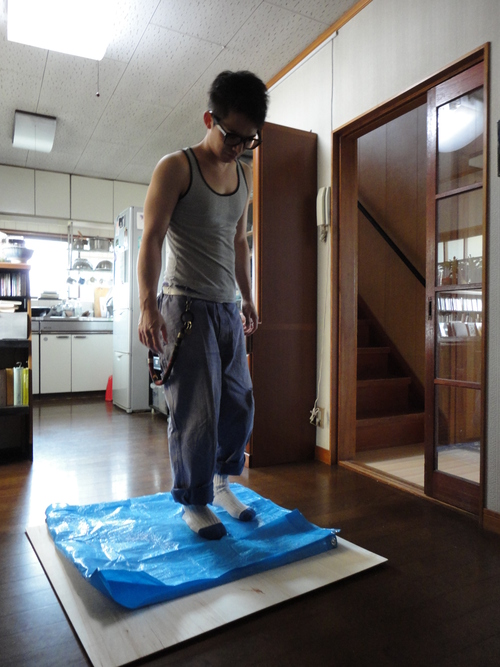
Kneading with the feet at our house
Most shops now have to use machines at least for kneading to keep up with demand, but some still knead, roll and cut by hand (or foot) for customers who come to eat them fresh.

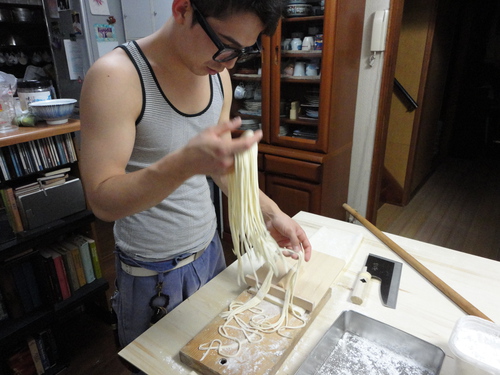
This homemade tradition makes Kagawans connoisseurs. Locals will argue delightedly over which shop has the tastiest noodles, defined by texture, length and thickness, as well as which has the best broth and the greatest toppings and side dishes.
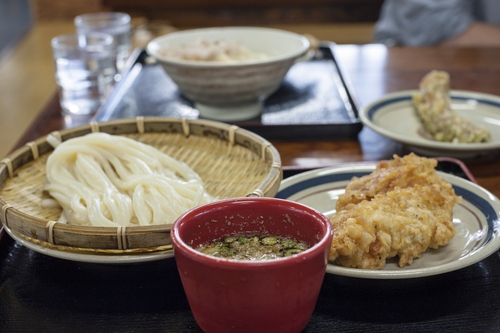
Chilled udon with dipping sauce and sides – Kirin, Takamatsu
That’s another distinguishing feature - diversity. There are over 900 udon shops serving a population of about 1 million, many of whom would willingly eat noodles for breakfast, lunch and dinner. Yet, except for a few chains, the noodles each produces are unique, and this diversity keeps noodle-lovers from getting bored. Every shop has its own carefully guarded recipe for udon and broth, often passed down through the generations, and each is aiming to make the best noodles ever. The taste is imprinted on the tongues of their customers who are quick to note any change.

Udon maestro at Hariya, where impeccable timing ensures perfectly fresh noodles and toppings
Each shop has its own ambience, too. Some are restaurant style, but many deliver most of their noodles to supermarkets, schools, businesses, etc. Those who want to eat in the shop must serve themselves, sometimes even to the point of chopping their own scallions.
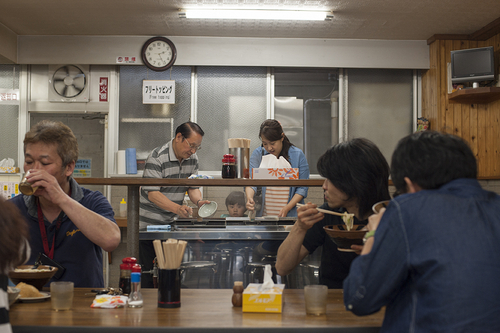
Inside Chikusei, Takamatsu – Customers heat up their own noodles
When noodles set aside for onsite consumption are gone, you’re out of luck, which can happen within 1 to 2 hours. You can tell a popular udon shop by the queue of people hoping to get a bowl before it runs out.
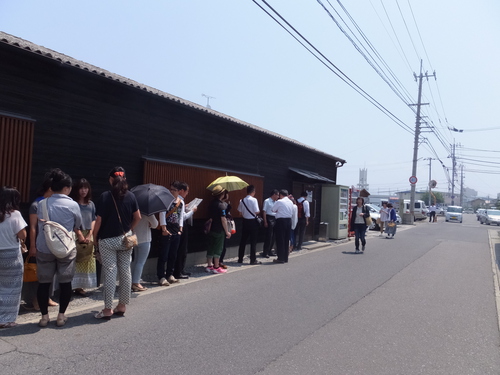
Udon lovers lining up outside Hariya before opening

Lining up inside, too
So what makes Sanuki udon so special? The whole experience. And that, I am afraid, we can’t export so you will just have to come to Takamatsu and experience it for yourself.
(ps. the best photos above are courtesy of Skye Hohmann)
Coming soon!!
Kagawa Waterfront Festival
July 19-August 8 at Sunport. Will include 15-minute hologram shows on a giant water screen in the sea. Come and enjoy art, dynamic historical storytelling, and entertainment. Shows are at 19:40, 20:30 and 21:20 at Sunport. For more details (in Japanese) see: http://www.pref.kagawa.jp/seto80/event/waterfront.html
Sensory Dining in Tamamo Park
Gourmet cuisine served in an exquisite manor house coupled with works produced by top Kagawan artists and artisans make for a special dining experience. http://www.takumikumo.com/shiro-cafe/
For more info on Takamatsu:
http://wikitravel.org/en/Takamatsu
http://www.city.takamatsu.kagawa.jp/english/
http://tia-takamatsu.jp/
http://www.my-kagawa.jp/eg/
Other Takamatsu bloggers:
http://pat.ashita-sanuki.jp/
http://ogijima.com

Piping hot noodles with butter, fresh-ground pepper and egg at Bakaichidai, Takamatsu
Sanuki udon is both the fast food and the comfort food of Kagawa. As this is the driest region of Japan, people traditionally grew wheat, which requires much less water, to supplement the rice crop, and wheat noodles remain a local staple.

Wheat growing near my house in Takamatsu
Thanks to modern machinery, udon equivalent in texture and taste can now be had not only all over Japan but in other countries as well. While the noodles are good, however, I can testify that something vital is missing.
Udon-making machine in a Sanuki udon shop in Tokyo
Take pride and passion, for instance. Until recently, many Kagawans made udon at home. Traditionally, the firm, silky texture was produced by kneading with the feet.
Kneading with the feet at our house
Most shops now have to use machines at least for kneading to keep up with demand, but some still knead, roll and cut by hand (or foot) for customers who come to eat them fresh.
This homemade tradition makes Kagawans connoisseurs. Locals will argue delightedly over which shop has the tastiest noodles, defined by texture, length and thickness, as well as which has the best broth and the greatest toppings and side dishes.

Chilled udon with dipping sauce and sides – Kirin, Takamatsu
That’s another distinguishing feature - diversity. There are over 900 udon shops serving a population of about 1 million, many of whom would willingly eat noodles for breakfast, lunch and dinner. Yet, except for a few chains, the noodles each produces are unique, and this diversity keeps noodle-lovers from getting bored. Every shop has its own carefully guarded recipe for udon and broth, often passed down through the generations, and each is aiming to make the best noodles ever. The taste is imprinted on the tongues of their customers who are quick to note any change.
Udon maestro at Hariya, where impeccable timing ensures perfectly fresh noodles and toppings
Each shop has its own ambience, too. Some are restaurant style, but many deliver most of their noodles to supermarkets, schools, businesses, etc. Those who want to eat in the shop must serve themselves, sometimes even to the point of chopping their own scallions.

Inside Chikusei, Takamatsu – Customers heat up their own noodles
When noodles set aside for onsite consumption are gone, you’re out of luck, which can happen within 1 to 2 hours. You can tell a popular udon shop by the queue of people hoping to get a bowl before it runs out.
Udon lovers lining up outside Hariya before opening
Lining up inside, too
So what makes Sanuki udon so special? The whole experience. And that, I am afraid, we can’t export so you will just have to come to Takamatsu and experience it for yourself.
(ps. the best photos above are courtesy of Skye Hohmann)
Coming soon!!
Kagawa Waterfront Festival
July 19-August 8 at Sunport. Will include 15-minute hologram shows on a giant water screen in the sea. Come and enjoy art, dynamic historical storytelling, and entertainment. Shows are at 19:40, 20:30 and 21:20 at Sunport. For more details (in Japanese) see: http://www.pref.kagawa.jp/seto80/event/waterfront.html
Sensory Dining in Tamamo Park
Gourmet cuisine served in an exquisite manor house coupled with works produced by top Kagawan artists and artisans make for a special dining experience. http://www.takumikumo.com/shiro-cafe/
For more info on Takamatsu:
http://wikitravel.org/en/Takamatsu
http://www.city.takamatsu.kagawa.jp/english/
http://tia-takamatsu.jp/
http://www.my-kagawa.jp/eg/
Other Takamatsu bloggers:
http://pat.ashita-sanuki.jp/
http://ogijima.com
Posted by cathy at
11:06
│Comments(0)
2014年05月30日
Ritsurin Garden Events
From spring through fall, there are plenty of events to enjoy at Ritsurin Garden. In May, the garden’s Folkcraft Museum featured beautiful old kites and banners with themes related to Boys’ Day.
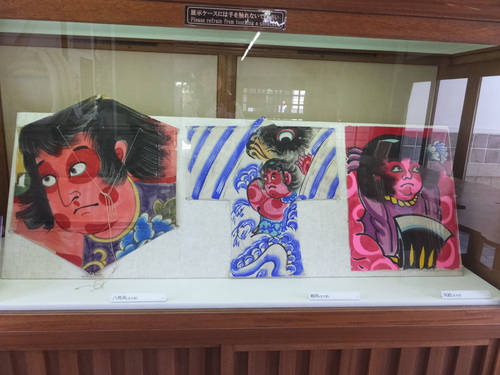
Boys’ Day (May 5) was renamed “Children’s Day” a few decades ago in the interest of gender equality, but the motifs showed that the festival’s origins were definitely male-oriented. The kites and banners featured heroes from Japanese folktales and warriors from famous battles, such as the Genpei Wars of the 12th century.

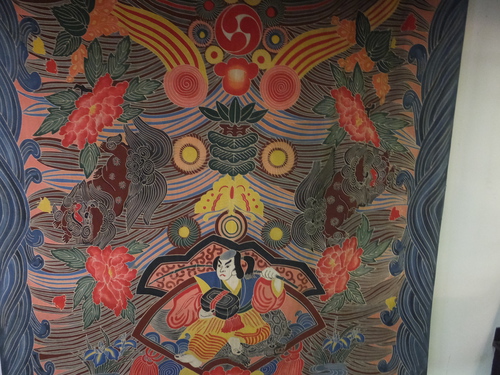

The exhibit was very tastefully done and the regular permanent exhibit surrounding the works really added to the atmosphere. On weekends, the neighboring building hosts craftsmen who demonstrate how their works are made. When I went, I was treated to exhibitions by a lacquer artist and a wood carver.
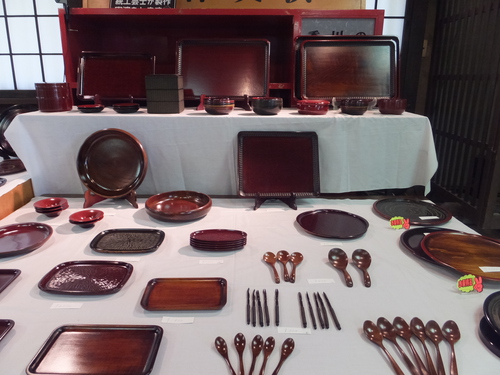
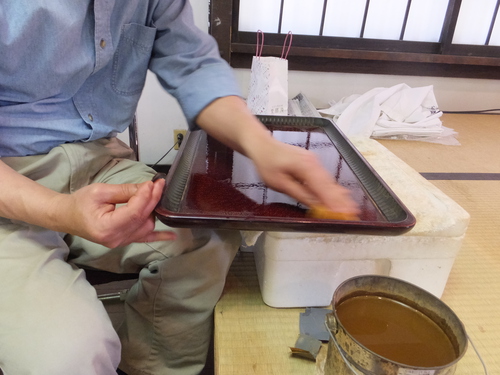


There was also a bonsai sale taking place just outside, with some lovely specimens.

Takamatsu produces 80% of the pine bonsai in Japan and a walk around Ritsurin Garden demonstrates that it has ancient roots in this town. Many of the pines in the garden have been trained into various shapes over the centuries and are meticulously and lovingly tended by a crew of gardeners.
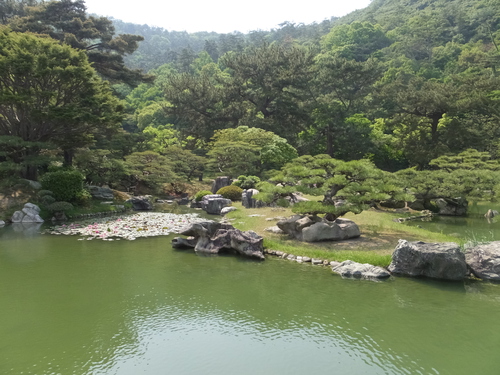
This visit, I learned that Ritsurin also has a medicinal garden. One of the “medicines” cultivated now is green tea.
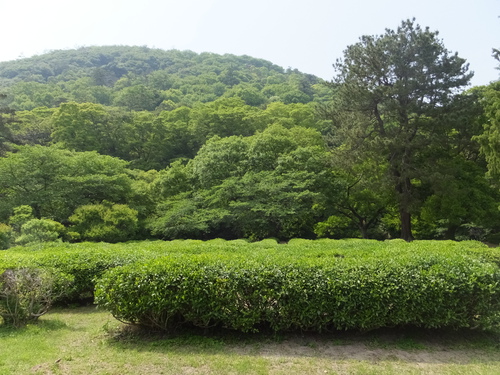
A tea-picking event is held annually and local people are invited to come and pick the tea in the garden. I wonder if that is the tea that is served in the two lovely teahouses that grace Ritsurin.

Free tea tasting was also being offered at the new building near the east entrance by some very sweet young ladies. It was not from the garden though.
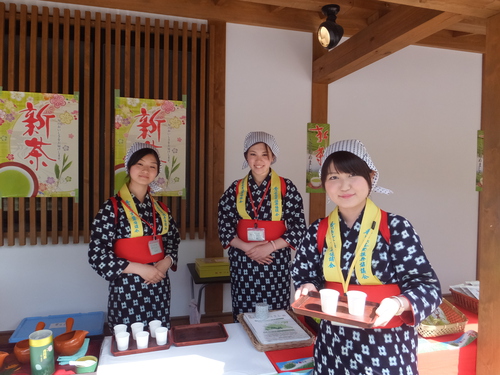
As I said, there’s lots happening at Ritsurin from spring through fall. Even when there are no events, the garden is designed so that something is in bloom in every season. So drop in when you need a break and enjoy.

For more on Ritsurin:
http://cathy.ashita-sanuki.jp/e229240.html
http://www.pref.kagawa.jp/ritsurin/gaiyou_e.html
For more info on Takamatsu:
http://wikitravel.org/en/Takamatsu
http://www.city.takamatsu.kagawa.jp/english/
http://tia-takamatsu.jp/
http://www.my-kagawa.jp/eg/
Other Takamatsu bloggers:
http://pat.ashita-sanuki.jp/
http://ogijima.com
Boys’ Day (May 5) was renamed “Children’s Day” a few decades ago in the interest of gender equality, but the motifs showed that the festival’s origins were definitely male-oriented. The kites and banners featured heroes from Japanese folktales and warriors from famous battles, such as the Genpei Wars of the 12th century.
The exhibit was very tastefully done and the regular permanent exhibit surrounding the works really added to the atmosphere. On weekends, the neighboring building hosts craftsmen who demonstrate how their works are made. When I went, I was treated to exhibitions by a lacquer artist and a wood carver.
There was also a bonsai sale taking place just outside, with some lovely specimens.
Takamatsu produces 80% of the pine bonsai in Japan and a walk around Ritsurin Garden demonstrates that it has ancient roots in this town. Many of the pines in the garden have been trained into various shapes over the centuries and are meticulously and lovingly tended by a crew of gardeners.
This visit, I learned that Ritsurin also has a medicinal garden. One of the “medicines” cultivated now is green tea.
A tea-picking event is held annually and local people are invited to come and pick the tea in the garden. I wonder if that is the tea that is served in the two lovely teahouses that grace Ritsurin.
Free tea tasting was also being offered at the new building near the east entrance by some very sweet young ladies. It was not from the garden though.
As I said, there’s lots happening at Ritsurin from spring through fall. Even when there are no events, the garden is designed so that something is in bloom in every season. So drop in when you need a break and enjoy.
For more on Ritsurin:
http://cathy.ashita-sanuki.jp/e229240.html
http://www.pref.kagawa.jp/ritsurin/gaiyou_e.html
For more info on Takamatsu:
http://wikitravel.org/en/Takamatsu
http://www.city.takamatsu.kagawa.jp/english/
http://tia-takamatsu.jp/
http://www.my-kagawa.jp/eg/
Other Takamatsu bloggers:
http://pat.ashita-sanuki.jp/
http://ogijima.com
Posted by cathy at
23:24
│Comments(0)
2014年05月30日
Busshozan
April and May are perfect months for getting outdoors in Takamatsu and that’s just what we did. During cherry blossom season, we dropped into Busshozan Park to join many others picnicking under the trees. There were families as well as large groups, some of whom were on an outing from a seniors’ home, but there was plenty of space for all.
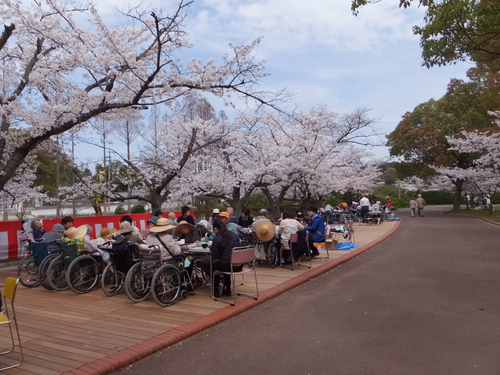

Busshozan Park is extensive with a gym, a swimming pool, playground equipment, and plenty of lawn space for playing Frisbee, badminton, tag or whatever else kids and adults like to play outside.


It’s also right on an ancient irrigation pond. Kagawa has the lowest rainfall in Japan, so water scarcity was a major problem until recent times. Kobo Daishi (774-835), the great scholar and monk who established the Shingon sect of Buddhism and the 88-temple pilgrimage route that goes around the island of Shikoku, also introduced superior engineering for ponds in the prefecture, although I’m not sure about this one in particular.

This year, 2014, marks the 1200th anniversary of the founding of this pilgrimage route and there will be many special events at the different temples throughout the year. Hopefully I’ll be able to cover some of those events as well.
But back to Busshozan, where the blossoms were splendid.

Cherry trees go right up the sides of the hill through the graveyard of the neighboring temple.
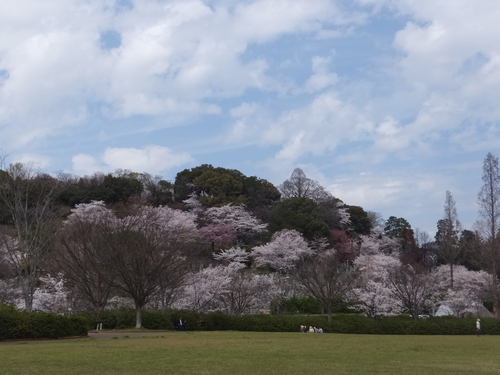
That temple would be Honenji, which I’ve covered before (see http://cathy.ashita-sanuki.jp/d2012-11-02.html ) and is well worth a visit. When we went, they were holding their regular flower market as well as selling udon noodles and cookies made by residents of the temple’s facility for people with disabilities.
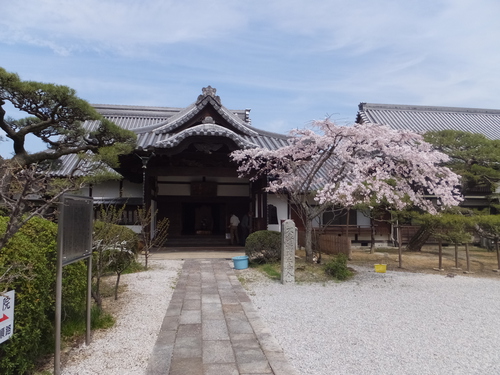
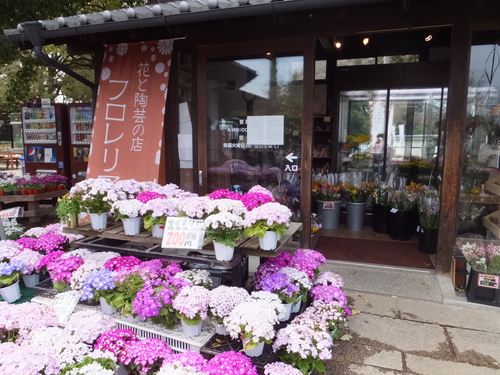
It was recently discovered that the park lies on top of the Takamatsu crater, which measures 4 km in diameter and 2 km deep. Boring samples indicate that it was probably caused by a meteorite impact. As a result, Busshozan has one of the best natural hotsprings in Shikoku. If you’re going to the park to play sports, I recommend dropping into the Busshozan Onsen hot spring bath on your way home for a relaxing soak.
For more info on Takamatsu:
http://wikitravel.org/en/Takamatsu
http://www.city.takamatsu.kagawa.jp/english/
http://tia-takamatsu.jp/
http://www.my-kagawa.jp/eg/
Other Takamatsu bloggers:
http://pat.ashita-sanuki.jp/
http://ogijima.com


Busshozan Park is extensive with a gym, a swimming pool, playground equipment, and plenty of lawn space for playing Frisbee, badminton, tag or whatever else kids and adults like to play outside.


It’s also right on an ancient irrigation pond. Kagawa has the lowest rainfall in Japan, so water scarcity was a major problem until recent times. Kobo Daishi (774-835), the great scholar and monk who established the Shingon sect of Buddhism and the 88-temple pilgrimage route that goes around the island of Shikoku, also introduced superior engineering for ponds in the prefecture, although I’m not sure about this one in particular.

This year, 2014, marks the 1200th anniversary of the founding of this pilgrimage route and there will be many special events at the different temples throughout the year. Hopefully I’ll be able to cover some of those events as well.
But back to Busshozan, where the blossoms were splendid.

Cherry trees go right up the sides of the hill through the graveyard of the neighboring temple.

That temple would be Honenji, which I’ve covered before (see http://cathy.ashita-sanuki.jp/d2012-11-02.html ) and is well worth a visit. When we went, they were holding their regular flower market as well as selling udon noodles and cookies made by residents of the temple’s facility for people with disabilities.


It was recently discovered that the park lies on top of the Takamatsu crater, which measures 4 km in diameter and 2 km deep. Boring samples indicate that it was probably caused by a meteorite impact. As a result, Busshozan has one of the best natural hotsprings in Shikoku. If you’re going to the park to play sports, I recommend dropping into the Busshozan Onsen hot spring bath on your way home for a relaxing soak.
For more info on Takamatsu:
http://wikitravel.org/en/Takamatsu
http://www.city.takamatsu.kagawa.jp/english/
http://tia-takamatsu.jp/
http://www.my-kagawa.jp/eg/
Other Takamatsu bloggers:
http://pat.ashita-sanuki.jp/
http://ogijima.com
Posted by cathy at
22:39
│Comments(0)
2014年03月31日
Souvenirs with a Twist
Shikoku Shop 88 is located just across from JR Takamatsu Station in the Sunport Plaza complex. When I first saw it, I thought it was just another souvenir shop but today I learned otherwise.
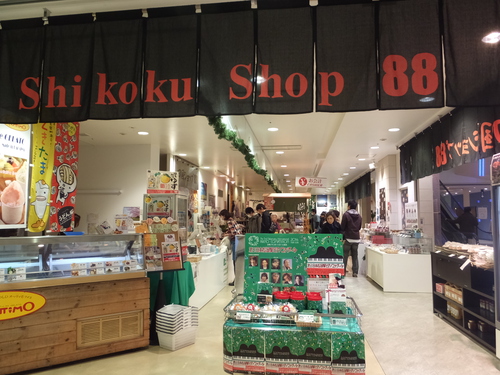
Established in December 2013 by Ikomaya, a Shodoshima-based noodle company, it sells products from all parts of Shikoku. While it does stock the traditional favorites, its mission is to showcase the extremely local and the unique. Broad bean or olive ice cream anyone?
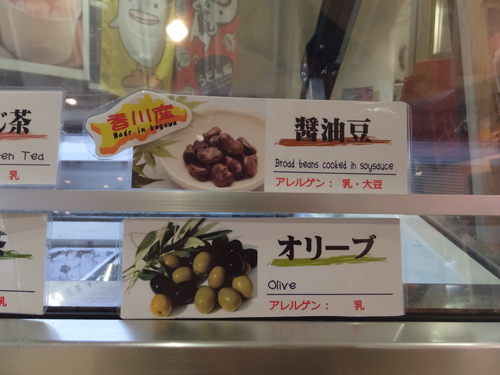
This little fellow seemed very interested in the drink machine.
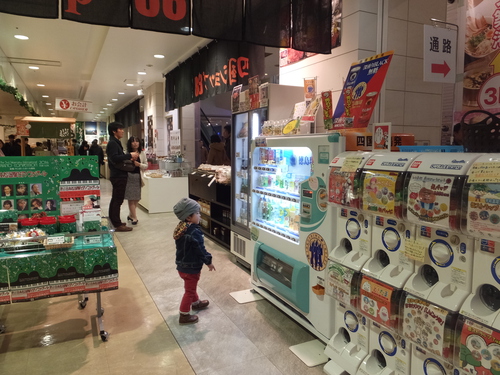
And for a good reason: it sells only Tokushima Coffee products, a company I had never heard of, although the drinks looked very familiar.
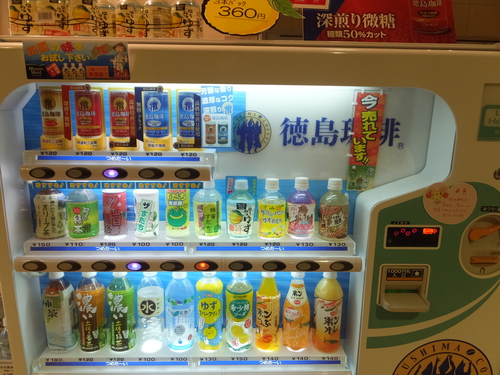
The store features an impressive collection of capsule toy machines known as “gachapon”. The contents are devoted to a wild and weird array of mascot characters from little towns and villages in Shikoku.
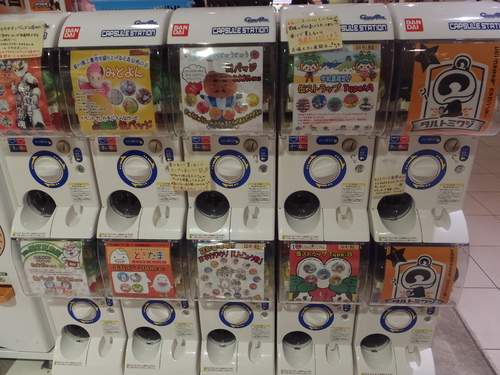
Ikomaya negotiated with the gachapon maker to insert these goods into capsules and became the only shop selling them in the world (at least for now). Predictably, there were several using our own local specialty, Sanuki udon (noodles) as a motif.
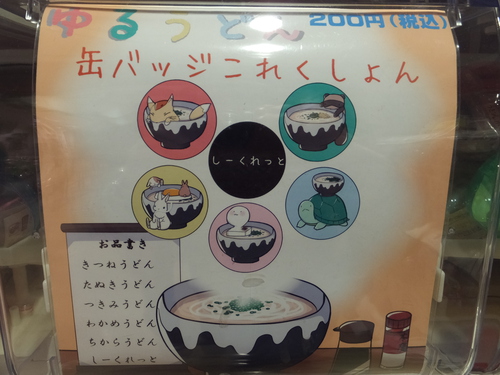

Local products also included special designer goods commemorating the 3rd Takamatsu International Piano Competition.

I am not sure if people anywhere else will recognize this little gift but it’s a piano keyboard and a bowl of udon noodles made from local handcrafted wasanbon sugar.

Here are a few things I brought home to try. Gummy noodles (lemon flavored and extremely chewy), carrot rusks and Hiraga Gennai coffee. (Hiraga Gennai was an 18th century local inventor.) All with very original packaging.
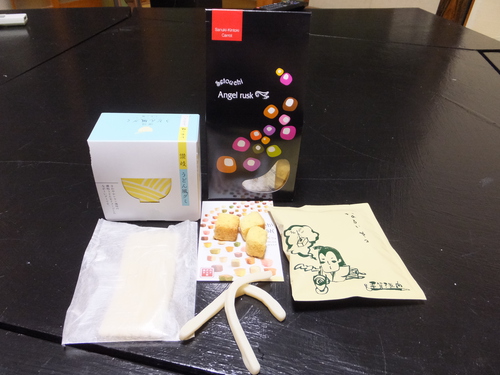
I was amazed to find that we have our own local super heroes! Remujia (which read backwards in Japanese is “aji-mure”, two local villages famous for their aji granite and stone masons). Where were these guys when I needed them?
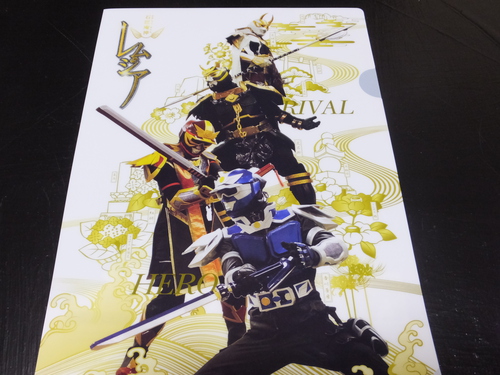
And look at these seals featuring two cute girls? This is Kirara Takano and Mai Awano, representing the Nankai Ferry that runs between Wakayama and Tokushima. Ordinarily, Kirara and Mai goods can only be purchased at the Nankai Ferry but Shikoku Shop 88 got special permission to carry them.
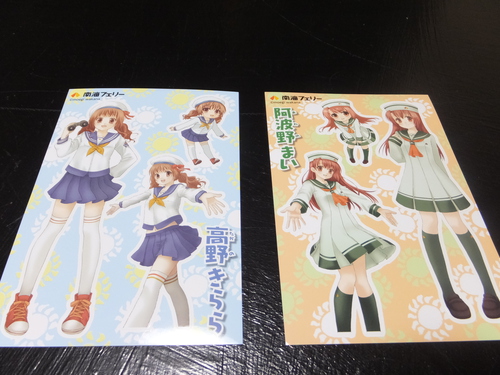
As you can see, it’s an interesting little shop to check out if you want something local but different. And, if you’re set on doing Shikoku’s 88 pilgrim route, you can get everything you need here from the white jacket to the staff, straw hat and prayer beads, without waiting until you get to a temple.
For more info on Takamatsu:
http://wikitravel.org/en/Takamatsu
http://www.city.takamatsu.kagawa.jp/english/
http://tia-takamatsu.jp/
http://www.my-kagawa.jp/eg/
Other Takamatsu bloggers:
http://pat.ashita-sanuki.jp/
http://ogijima.com

Established in December 2013 by Ikomaya, a Shodoshima-based noodle company, it sells products from all parts of Shikoku. While it does stock the traditional favorites, its mission is to showcase the extremely local and the unique. Broad bean or olive ice cream anyone?

This little fellow seemed very interested in the drink machine.

And for a good reason: it sells only Tokushima Coffee products, a company I had never heard of, although the drinks looked very familiar.

The store features an impressive collection of capsule toy machines known as “gachapon”. The contents are devoted to a wild and weird array of mascot characters from little towns and villages in Shikoku.

Ikomaya negotiated with the gachapon maker to insert these goods into capsules and became the only shop selling them in the world (at least for now). Predictably, there were several using our own local specialty, Sanuki udon (noodles) as a motif.


Local products also included special designer goods commemorating the 3rd Takamatsu International Piano Competition.

I am not sure if people anywhere else will recognize this little gift but it’s a piano keyboard and a bowl of udon noodles made from local handcrafted wasanbon sugar.

Here are a few things I brought home to try. Gummy noodles (lemon flavored and extremely chewy), carrot rusks and Hiraga Gennai coffee. (Hiraga Gennai was an 18th century local inventor.) All with very original packaging.

I was amazed to find that we have our own local super heroes! Remujia (which read backwards in Japanese is “aji-mure”, two local villages famous for their aji granite and stone masons). Where were these guys when I needed them?

And look at these seals featuring two cute girls? This is Kirara Takano and Mai Awano, representing the Nankai Ferry that runs between Wakayama and Tokushima. Ordinarily, Kirara and Mai goods can only be purchased at the Nankai Ferry but Shikoku Shop 88 got special permission to carry them.

As you can see, it’s an interesting little shop to check out if you want something local but different. And, if you’re set on doing Shikoku’s 88 pilgrim route, you can get everything you need here from the white jacket to the staff, straw hat and prayer beads, without waiting until you get to a temple.
For more info on Takamatsu:
http://wikitravel.org/en/Takamatsu
http://www.city.takamatsu.kagawa.jp/english/
http://tia-takamatsu.jp/
http://www.my-kagawa.jp/eg/
Other Takamatsu bloggers:
http://pat.ashita-sanuki.jp/
http://ogijima.com
Posted by cathy at
21:11
│Comments(0)
2014年03月24日
Thatching in Shikokumura
Spring is here at last! Today, I dropped into Shikokumura to truly enjoy it.
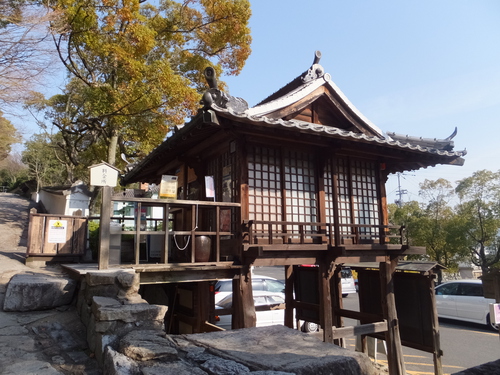
Shikokumura entrance
Perched on the slope of Mount Yashima, this outdoor historical museum presents not only exquisite examples of traditional building styles
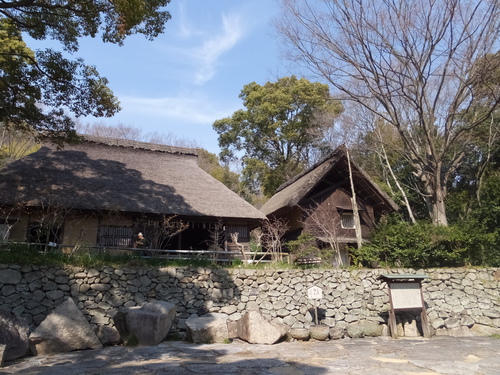
but also a profusion of botanical specimens.
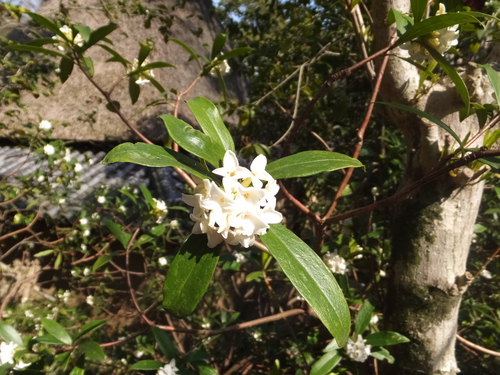

Both flora and architecture can be appreciated while hiking along artfully arranged paths of stone and old railway ties that are edged with moss, bamboo, streams and waterfalls.
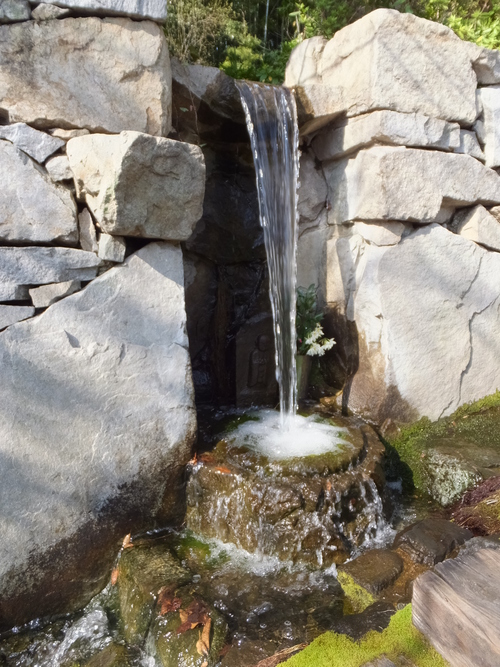
When I dropped into the museum today, I had the added treat of seeing thatchers at work because the sugar press huts are being re-thatched.
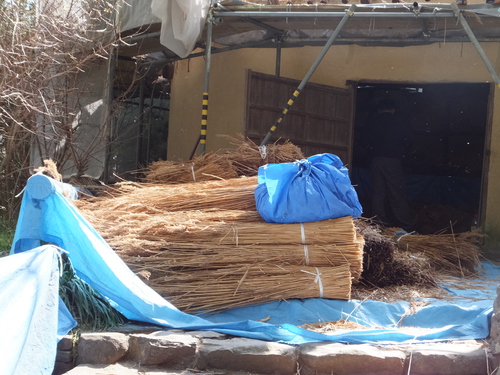

Much like barn-raising in rural Canada where I hail from, thatching was once a community activity involving the whole village. In Shikoku, however, the art has almost died out. Many traditionally shaped peaked roofs that obviously used to be thatched are now covered in metal instead.
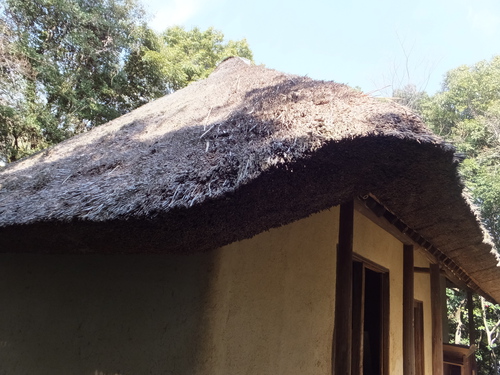
It’s a shame really as thatch seems far more ecological than most building materials in use today. Unlike tiled roofs, the materials were readily at hand, growing in wetlands and purifying the water, and compared to the thick clay tiles used in Japan, thatching is still within the realm of “do-it-yourself” technology.
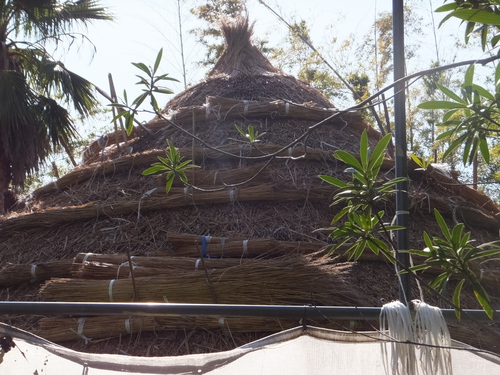
The heavy thatched roofs made for a very cool interior during the hot humid summers of Japan and for a warm interior in winter.

Now, however, materials are scarce as most wetlands have been filled in and built over, the demand for thatching is low, and few people remember how to thatch. Modernization, coupled with the fact that thatch is more vulnerable to fire than tiles contributed to the decline of this roofing technique. Considering the state of the environment, perhaps we should consider reviving this renewable approach to architecture.

If you can visit soon, you should be able to see the work in progress. And if you go before March 31, you can also catch the hina-matsuri dolls exhibited in various buildings on site.
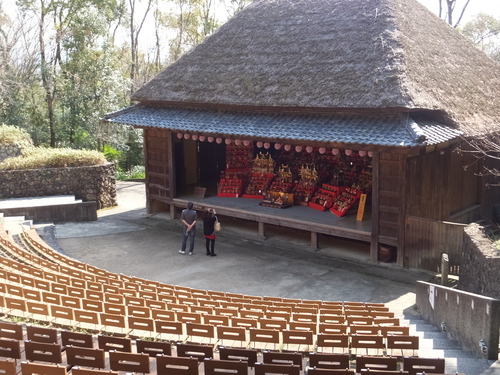
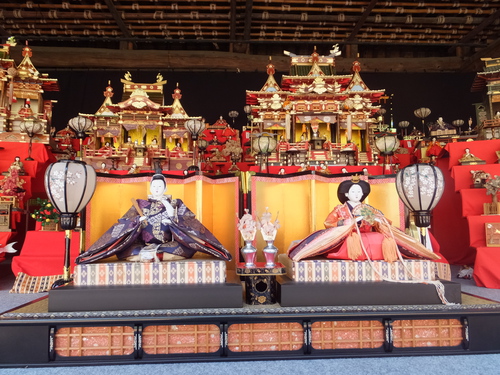
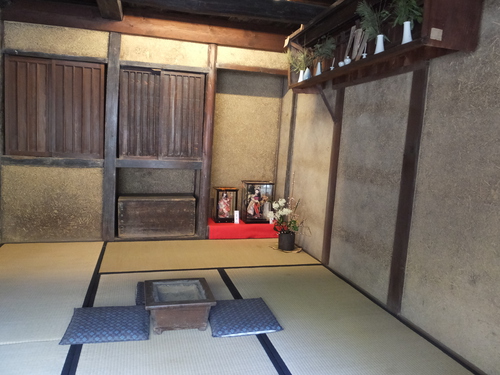
For details, see http://www.yashima-artvillage.jp/english/museum/shikokumura.html
For more info on Takamatsu:
http://wikitravel.org/en/Takamatsu
http://www.city.takamatsu.kagawa.jp/english/
http://tia-takamatsu.jp/
http://www.my-kagawa.jp/eg/
Other Takamatsu bloggers:
http://pat.ashita-sanuki.jp/
http://ogijima.com

Shikokumura entrance
Perched on the slope of Mount Yashima, this outdoor historical museum presents not only exquisite examples of traditional building styles

but also a profusion of botanical specimens.


Both flora and architecture can be appreciated while hiking along artfully arranged paths of stone and old railway ties that are edged with moss, bamboo, streams and waterfalls.

When I dropped into the museum today, I had the added treat of seeing thatchers at work because the sugar press huts are being re-thatched.


Much like barn-raising in rural Canada where I hail from, thatching was once a community activity involving the whole village. In Shikoku, however, the art has almost died out. Many traditionally shaped peaked roofs that obviously used to be thatched are now covered in metal instead.

It’s a shame really as thatch seems far more ecological than most building materials in use today. Unlike tiled roofs, the materials were readily at hand, growing in wetlands and purifying the water, and compared to the thick clay tiles used in Japan, thatching is still within the realm of “do-it-yourself” technology.

The heavy thatched roofs made for a very cool interior during the hot humid summers of Japan and for a warm interior in winter.

Now, however, materials are scarce as most wetlands have been filled in and built over, the demand for thatching is low, and few people remember how to thatch. Modernization, coupled with the fact that thatch is more vulnerable to fire than tiles contributed to the decline of this roofing technique. Considering the state of the environment, perhaps we should consider reviving this renewable approach to architecture.

If you can visit soon, you should be able to see the work in progress. And if you go before March 31, you can also catch the hina-matsuri dolls exhibited in various buildings on site.



For details, see http://www.yashima-artvillage.jp/english/museum/shikokumura.html
For more info on Takamatsu:
http://wikitravel.org/en/Takamatsu
http://www.city.takamatsu.kagawa.jp/english/
http://tia-takamatsu.jp/
http://www.my-kagawa.jp/eg/
Other Takamatsu bloggers:
http://pat.ashita-sanuki.jp/
http://ogijima.com
Posted by cathy at
23:12
│Comments(0)
2014年02月28日
Dolls and Doll Makers
March 3 is Hinamatsuri, a festival to wish for the health and happiness of one’s daughters. Families with daughters traditionally set up an elaborate set of ceremonial dolls consisting of an empress with her consort and servants. You can enjoy some beautiful and rare examples of these doll sets in Shikokumura until March 24 (see end for details).

Hariko dolls
Speaking of dolls, Takamatsu has its own tradition of manufacturing “hariko” or paper mache dolls (photo above). The skill was introduced from Osaka sometime in the 17th century. One particular type of hariko doll originated in Takamatsu: Hokosan.
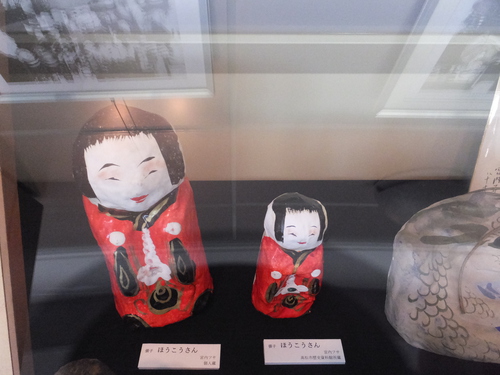
2 sizes of hokosan
Hokosan is modeled after a faithful serving girl, Ohmaki, who died so that her mistress would be cured of a serious illness (in some versions, she saves her master). Paper mache dolls in her image came to be used as protective charms for children. Today, they have become popular souvenirs.
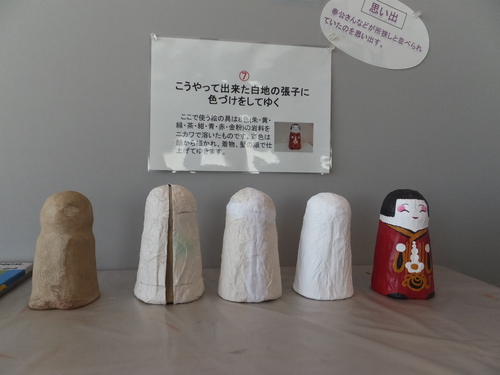
Hariko dolls are made of layers washi (Japanese paper) and rice glue over a clay mold.
One of the best known hariko doll makers in Kagawa was Fusa Miyauji (1883-1985). She herself said that she made about 250 varieties of hariko, and they were of all sizes from tiny to huge.
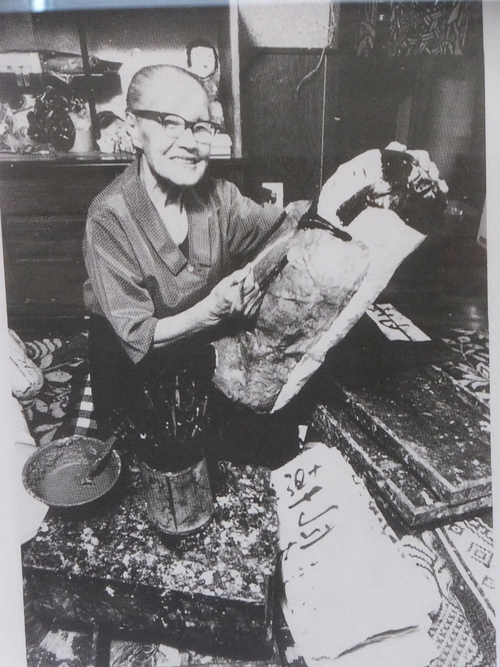
Fusa Miyauji making a large Hokosan
Miyauji learned the trade from her father, who revived the dying craft. She then took it to a new level. The artistic merit of her work won her fans in both Japan and overseas. Here are some examples from a recent exhibit at the Stone Museum.

Tenjin (god of scholarship) riding a cow (featured on a commemorative stamp)

Piggyback ride

The folk hero Kintaro with tigers

A happy looking fisherman
Some of Fusa Miyauji works can also be seen in the Sanuki Folkcraft Museum in Ritsurin Garden http://www.pref.kagawa.lg.jp/ritsurin/index_e.html )

Fusa Miyauji at work. She passed her skills on to her daughters, and at least one granddaughter. You can find hariko at folkcraft and souvenir shops in Takamatsu.
Shikokumura Doll Festival
Content: 33 doll sets are displayed in different buildings centered on the rural kabuki theater. This means that you can enjoy a lovely hike among the spring flowers when you go. In addition, the thatch roof of the sugar shack is being replaced during this time making this a rare opportunity to observe how thatching, a dying art, is done.
Dates: Feb 8 – Mar 24, 2014
Hours: 8:30-16:30
Park Admission: Adults JPY800 (High school JPY500, under 15 JPY300)
For more info on Takamatsu:
http://wikitravel.org/en/Takamatsu
http://www.city.takamatsu.kagawa.jp/english/
http://tia-takamatsu.jp/
http://www.my-kagawa.jp/eg/
Other Takamatsu bloggers:
http://pat.ashita-sanuki.jp/
http://ogijima.com

Hariko dolls
Speaking of dolls, Takamatsu has its own tradition of manufacturing “hariko” or paper mache dolls (photo above). The skill was introduced from Osaka sometime in the 17th century. One particular type of hariko doll originated in Takamatsu: Hokosan.

2 sizes of hokosan
Hokosan is modeled after a faithful serving girl, Ohmaki, who died so that her mistress would be cured of a serious illness (in some versions, she saves her master). Paper mache dolls in her image came to be used as protective charms for children. Today, they have become popular souvenirs.

Hariko dolls are made of layers washi (Japanese paper) and rice glue over a clay mold.
One of the best known hariko doll makers in Kagawa was Fusa Miyauji (1883-1985). She herself said that she made about 250 varieties of hariko, and they were of all sizes from tiny to huge.

Fusa Miyauji making a large Hokosan
Miyauji learned the trade from her father, who revived the dying craft. She then took it to a new level. The artistic merit of her work won her fans in both Japan and overseas. Here are some examples from a recent exhibit at the Stone Museum.

Tenjin (god of scholarship) riding a cow (featured on a commemorative stamp)

Piggyback ride

The folk hero Kintaro with tigers

A happy looking fisherman
Some of Fusa Miyauji works can also be seen in the Sanuki Folkcraft Museum in Ritsurin Garden http://www.pref.kagawa.lg.jp/ritsurin/index_e.html )

Fusa Miyauji at work. She passed her skills on to her daughters, and at least one granddaughter. You can find hariko at folkcraft and souvenir shops in Takamatsu.
Shikokumura Doll Festival
Content: 33 doll sets are displayed in different buildings centered on the rural kabuki theater. This means that you can enjoy a lovely hike among the spring flowers when you go. In addition, the thatch roof of the sugar shack is being replaced during this time making this a rare opportunity to observe how thatching, a dying art, is done.
Dates: Feb 8 – Mar 24, 2014
Hours: 8:30-16:30
Park Admission: Adults JPY800 (High school JPY500, under 15 JPY300)
For more info on Takamatsu:
http://wikitravel.org/en/Takamatsu
http://www.city.takamatsu.kagawa.jp/english/
http://tia-takamatsu.jp/
http://www.my-kagawa.jp/eg/
Other Takamatsu bloggers:
http://pat.ashita-sanuki.jp/
http://ogijima.com
Posted by cathy at
20:10
│Comments(0)




